- Medical School

AACOMAS Personal Statement Examples

The AACOMAS personal statement is required as part of your DO school application . Your personal statement gives admissions committees information about why you chose osteopathic medicine and why you want to be a doctor . Before you sit down to write your own statement, learn how to craft a perfect AACOMAS personal statement in our blog and take time read some outstanding AACOMAS personal statement examples to get inspiration for your own!
>> Want us to help you get accepted? Schedule a free initial consultation here <<
Listen to the blog!
Article Contents 12 min read
A personal statement is a required component of a primary medical school application , regardless of whether the application is submitted through TMDSAS , AMCAS or AACOMAS . The AACOMAS personal statement is unique to those applying to DO programs and gives admissions committees information about an applicant's motivation and passion for pursuing osteopathic medicine. While it may take days or weeks to craft an AACOMAS personal statement, it can take admissions committees less than five minutes to review, assess, and decide if they're interested in learning more about an applicant. For this reason, it's essential to make sure your AACOMAS personal statement attracts attention from the start and is captivating enough to maintain interest throughout. This blog will go over what you need to know about the AACOMAS personal statement, what to include, tips to write an effective statement aa well as AACOMAS personal statement examples that will illustrate key characteristics of successful AACOMAS essays.
AACOMAS stands for the American Association of Colleges of Osteopathic Medicine Application Service. It is an online system used by applicants applying to osteopathic programs in the US. Applicants submit one application that includes all necessary documents to AACOMAS, the documents are verified and are then transmitted to all selected programs. The AACOMAS application cycle normally opens in May and closes in April of the following year.
AACOMAS General Timeline
This section will go over a basic timeline for AACOMAS , for a more in-depth look into the DO school application process, check out our blog for more details. In addition, if you're wondering “ when do medical school applications open ” review our medical school application timelines blog.
While the AACOMAS personal statement is similar to the TMDSAS personal statement and the AMCAS personal statement , it's important to note that they are not the same. The first difference is the length, the AACOMAS personal statement is limited to 5300 characters including spaces, which is roughly 700 words. Both the TMDSAS and AMCAS personal statements are similar, at 5000 and 5300 characters, including spaces, respectively. Other than length, the next major difference to consider is the content. Check out our blog for TMDSAS personal statement examples . While there are similarities between allopathic and osteopathic medicine, there are also differences that you should understand. Our blog, DO vs MD , outlines some of these key differences and similarities to help you tailor your personal statement appropriately.
How to write an AACOMAS personal statement
An AACOMAS personal statement is a way of introducing the admissions committee to who you are as a person and as a candidate. The main purpose of the essay is to answer the question “why do you want to be a doctor?” and specifically, why do you want to be an osteopathic doctor? Be sure you understand what DO stands for and what it means to be a DO. Before you sit down to write your essay, check out quality medical school personal statement examples and residency personal statement examples to get some inspiration. It is of utmost importance that your personal statement demonstrates, through examples, your understanding and commitment to the principles of osteopathic medicine . Remember, do not simply list these principles and state that they are important to you, you need to ensure your statement shows instead of tells by supporting your discussion through experience-based evidence. Crafting an effective personal statement takes time and a lot of self-reflection. You'll need to ask yourself specific questions to help you gain insight into why you've chosen osteopathic medicine as your career path. When did you develop an interest in osteopathic medicine? What experiences led to your interest evolving into dedication and passion? What values and experiences allow you to put others first and dedicate yourself to helping others? What is your inspiration for working towards your short term and long term goals? What makes you unique as an applicant and how can your individual skills and experiences help you succeed as an osteopathic doctor?
An effective personal statement should always begin with something that is both unique and interesting. Not only will this help set you apart from other applicants, it's also a way to pique the interest of the admissions committee and give them a reason to continue reading your personal statement. Remember, the admissions committee will be reviewing hundreds if not thousands of applications, you need a personalized hook to draw them in and keep them. There is an endless possibility of unique opening paragraphs, if you're struggling to find yours, think about a significant accomplishment, an important hobby or even a challenging or moving experience that you may want to discuss.
The most successful medical school personal statements take the reader on a journey through their life. The admissions committee will be interested in where your interest in osteopathic medicine begin, how it developed over time and what experiences led you to choose this particular career path. Lastly, it's important to show how your experiences will prove useful in helping you reach your short term and long term goals and how your experiences and unique skill set will prepare you for a career as an osteopathic doctor.
There are three main elements to a free-skating routine: the jumps, the spins, and the footwork. Each has its own set of rules requiring precision in body placement and timing. I grew to appreciate the attention to detail in each element to avoid finding myself on the floor yet again, which allowed me to represent the southern region at the national championships for 8 years. In that perspective, it seems only natural I would bring that appreciation into my academic life and gravitate towards medicine, a highly methodical career path.
At university, I sought opportunities in biology, business, and dance. Rather than shying away from difficult, non required courses, I took classes such as “Determinative Bacteriology” and “Histology” that exposed me to detailed biochemical processes. My business courses taught me the success of a marketing campaign hinges on the compatibility of a service with its target audience, a lesson that could be applied when designing treatment plans to encourage patient compliance. Alternatively, ballet and dance emphasized total body control from fingertip to toe point in the execution of each movement, similar to the precision surgery demands. In each discipline, the classes I found most interesting were those that focused on breaking down large concepts into their constitutive parts. While each of these components cultivated my curiosity for medicine, it was my internship that confirmed my passion for medicine.
At St Joseph's Hospital, I shadowed an osteopathic physician who demonstrated both technical precision and compassion that drew me to the profession. I witnessed how in spite of the chaotic patient waiting room, Dr Jean maintained a smile greeting each patient. When a young woman came in complaining of migraines, Dr Jean was able to ask specific questions that concluded the patient’s lifestyle attributed to the pain she was enduring. She felt at ease and comfortable to share sensitive information. These qualities spoke volumes about the type of physician Dr Jean was. He was able to provide not only the care but compassion this patient required. Observing the interactions with the medical field ignited a passion I had seen only once before: when I decided I wanted to skate.
Originally I could not verbalize why I wanted to be a doctor. However, I have found a way to say it. When the people I loved were terminally ill, they just wanted time to reach one more milestone. My best friend’s mother wanted to watch her daughter graduate high school. My godfather wanted to reach his 65th birthday. Cancer and Parkinson’s disease will not let you set your own timetable, but sometimes medicine can help you reach just a little bit further. As a doctor, I’d like to be part of a team that gives my patient and their family just a little bit more time. With that time, my patient might walk their daughter down the aisle or celebrate one more birthday. Regardless of the situation, the time is priceless.
My road to medicine was not easy, but each trial has made me more resilient. In the midst of re-writing my medical school application in 2017, my engagement ended weeks before my wedding date. I was not prepared to finish my application, so I dove into a research project and began my graduate studies in medical sciences. I pushed my limits until I crashed, resulting in my worst academic semester. I was devastated, but this challenge enabled me to seek help to understand my experience and overcome it. I developed a healthier routine by reducing my caffeine consumption, exercising regularly, and learning to manage stress. I took a proactive role in academics by collaborating more and studying efficiently, resulting in better grades. Taking a more assertive stance in time-management and self-care has better equipped me for a career in medicine.
Throughout my life, I gravitated towards highly technical activities, from skating to academics. I broadened my education beyond what was integrated into my program and found these experiences strengthened my conviction to be a physician. While shadowing, I found that a set of rules requiring precision in both body placement and timing, governed healthcare too, inspiring my pursuit to delve deeper into medicine. In skating, years of hard work culminating into a single performance led me to stand proudly on the national podium with a bronze medal hanging around my neck. This time, I hope my years of hard work will permit me to stand on stage with a white coat.
It was the summer of 2009 during our annual trip to India to visit my grandma. I had just woken up when I noticed my barely conscious grandma suffering a stroke. As a young 13-year-old, I had many scary questions running through my head. "What happened?", “Was I about to lose her?” Throughout childhood, I looked up to my grandma. Seeing her helpless scared me, and exposed our fragility as humans. From taking vitals to performing surgery, I realized the physicians did everything they could to fight for my grandma’s health. Thankfully, my grandma had surgery and was eventually discharged. Inspired by their dedication, I decided that I too wanted to pursue medicine.
I continued to think of my grandmother's health scare. I kept wondering, could something be done to avoid these types of medical emergencies and alleviate patients’ suffering? One day, my mom persuaded me to attend a yoga retreat, and I quickly fell in love with the philosophy behind the practice of yoga. The idea that yoga can improve fitness and overall well-being intrigued me and made me aware of how closely linked the mind and body are to each other in the first place. My regular practice of yoga led me to attend a yoga certification course and I eventually became a certified yoga instructor with the desire to spread awareness of healthy living.
I ran free yoga workshops for children with autism spectrum disorder at a local sensory gym. I vividly remember working with a young five-year-old named Joe, who struggled to follow directions. Joe would get distracted by the surrounding toys every five minutes due to his attention deficit hyperactivity disorder and it would be a challenge to convince him to remain seated each time. I felt disheartened to see his frustration with tasks and his mother Tracy’s agony over whether his situation would ever improve. I felt fortunate to mentor them and make an impact through teaching yoga. At the end of every session, his mom came up to me to thank me for taking the time to help these children and providing their families with hope that their children could lead healthy and meaningful lives. The fact that Joe still remembers what I had taught him even after several years reaffirms my desire to become a primary care physician who seeks to relentlessly advocate for her patients and provide holistic, preventive care alongside medical treatment.
I took this philosophy with me as a college student when I shadowed a primary care physician in my hometown. I remember observing Dr. Lake as she treated a patient suffering from obesity. After reviewing the patient’s chart, Dr. Lake diagnosed the teenager as pre-diabetic. After asking about her symptoms, Dr. Lake also asked her about her family situation, lifestyle, and mental health. As an osteopathic physician herself, Dr. Lake wanted to prevent the worsening of symptoms by identifying the major stressors contributing to the disease and directing the patient to the most effective interventions. I watched as Dr. Lake addressed the patient’s concerns and held her hand while explaining the treatment plan. I soon discovered that the role of a primary care physician extends beyond using scientific knowledge to treat symptoms; it also involves a commitment to understanding the people behind the symptoms.
While working as a tutor on campus, I encountered a senior who suffered from a brain injury and struggled with physics. I realized that I had to be mindful of her condition and tailor my tutoring strategies to fit her needs. I simplified the concepts and I encouraged her. Fortunately, the student gained confidence and felt comfortable returning to me for guidance. In every session, my role as a tutor encompassed providing both academic and emotional support customized to each student. Similarly, medicine also involves a tailored approach to each patient.
Watching my grandma suffer a stroke created a desire to become a physician who relentlessly advocates for her patients. My exposure to healthcare abroad has increased my cross-cultural awareness, thereby motivating me to engage with patients more effectively. Whether it be for a struggling elderly student, a child with a developmental disorder, or a pre-diabetic teenager, social support must be integrated with the treatment of physical health. As a future physician, I will strive to not only provide medical treatment to my patients but also compassion and empathy. I look forward to embracing this challenging, but rewarding career.
1. Don't recycle your AMCAS personal statement
While some students simply shorten their AMCAS personal statement to use as their AACOMAS personal statement, we highly recommend you don't. Allopathic medicine and osteopathic medicine are not the same, the principles and perspectives of these two types of medicine differ greatly. The simple fact that you cannot apply to osteopathic programs through AMCAS is indicative of these differences, so simply shortening your AMCAS personal statement isn't going to show the admissions committee that you want to pursue osteopathic medicine, rather they will be able to tell that you simply shortened a different essay meant for a different school of medicine. What you write to convince an MD admissions committee of your suitability for the profession may not convince a DO admission committee.
2. Follow a specific journey
As previously mentioned, statements that take the reader through an applicant's journey, in chronological order are the most effective. Keep your journey focused and stick with a theme that reoccurs throughout your essay and is easily identified. Don't jump around to unrelated areas and don't discuss every single experience that you've had. Pick experiences that highlight your theme and strengthen your suitability for the profession.
3. Don't use cliches
You are an original person with individual thoughts, experiences, and skills. Don't rely on using tired expressions and cliches that don't allow your story to shine through. Stay away from terms that everyone uses and phrases that are commonly overused. Don't simply state that you love medicine and want to be a doctor, dive deeper into your true motivations and passions to craft a statement that is totally original and unique to you.
Your personal statement is one of the most important documents you will write in your medical career, after all, it acts as a first impression of who you are and what you can bring to the profession. A poorly written personal statement that is difficult to follow, with poor sentence structure, grammatical errors, and spelling mistakes is not going to showcase the best version of you, and the reality is, the admissions committee won't be interested in getting to know you further. If you're thinking of just throwing together something quickly and submitting it, don't bother. An effective, successful personal statement takes time and many revisions in order to get it just right. It's a good idea to enlist professional help in order to create a phenomenal statement that stands out.
5. Hook the reader instantly
The opening paragraph of your AACOMAS personal statement is one of the most important factors for a successful essay. If the reader isn't interested, they likely won't continue reading your statement. The introduction is your opportunity to stand out and show the admissions committee what makes you original.
Like our blog? Write for us ! >>
Have a question ask our admissions experts below and we'll answer your questions, get started now.
Talk to one of our admissions experts
Our site uses cookies. By using our website, you agree with our cookie policy .
FREE Training Webinar: How To Make Your Med School Application Stand Out
(and avoid the top 5 reasons that get 90% of applicants rejected).

2024 AACOMAS Application Guide for DO Schools
- By Med School Insiders
- April 8, 2024
- AACOMAS , Medical School Application
Applying to osteopathic (DO) medical schools is just as confusing, daunting, and tedious a task as it is to apply to allopathic (MD) medical schools . There are so many different steps to keep track of, and on top of that, you need to tailor your application to osteopathic medicine. A successful AACOMAS application requires patience, dedication, and the ability to juggle many moving pieces at once.
Use our osteopathic medical school application guide to understand the primary application process. We’ll outline an ideal application timeline, what you need to include in your application, mistakes to avoid, and frequently asked questions.
AMCAS vs. AACOMAS vs. TMDSAS Med School Applications —what’s the difference, and how do you choose?
DO Schools for Osteopathic Medicine

Osteopaths (DOs) differentiate themselves from allopathic doctors (MDs) with a whole-body, holistic approach that treats the person—not the symptoms. The focus of osteopathic medicine is preventing illness from ever occurring and recognizing the connections between the various systems and organs in the body and how they influence each other.
DOs have to complete four years of medical school followed by residency, just like MDs. Nearly every specialization available to an MD is available to a DO as well. That being said, generally, a DO degree does not have the same reputation as an MD degree. This is somewhat due to the fact that the statistics for acceptance for DO schools are often lower than allopathic (MD) schools. DOs also have a harder time practicing medicine outside of the United States.
Learn more about osteopathic principles and the differences between an MD and a DO in our guide: What Is a DO (Doctor of Osteopathy)?
Why Choose a DO School?
There are many reasons why you might choose to attend a DO school over an allopathic (MD) school. In some cases, it comes down to your philosophy on how to best treat people. DOs take pride in focusing on preventative medicine with a holistic approach to patient care.
Reasons to choose a DO school:
- You are passionate about osteopathic medicine.
- You are only planning to practice medicine in the United States.
- You have worked closely with osteopathic doctors or your mentor is a DO.
- You do not have a high enough GPA or MCAT score to get into allopathic (MD) schools.
If you want to attend an MD school but don’t have the right grades or MCAT score, Med School Insiders can help. Contact our team to learn more about our MCAT Tutoring , Courses , and Application Editing Services .
AACOMAS: Osteopathic Medicine Application Service
AACOMAS (The American Association of Colleges of Osteopathic Medicine Application Service) is the centralized online application service for colleges of osteopathic medicine in the United States. It is the primary application method for students pursuing osteopathic medicine.
AACOMAS simplifies the process of applying to osteopathic medical schools by only requiring students to submit one set of application materials. So long as you are only applying to DO schools, AACOMAS verifies, processes, and submits your materials to the schools you choose.
AACOMAS Medical School Application Timeline
The AACOMAS application opens for submissions around the beginning of May each year, and colleges start receiving applications around mid-June. Aim to get your application in soon after submissions open for your best chance of success.
Due to rolling admissions , your likelihood of getting into medical school decreases the later you submit your application, so staying on top of deadlines is critical. By deadlines, we don’t mean the last deadline for submissions—you should complete your primary application and your secondaires well before the actual deadline for submission.
Follow our timeline, which includes possible and ideal schedules.

The Anatomy of a DO Application
1. gpa and mcat score.
A high GPA and MCAT score is definitely something to be proud of, but they’re not as essential to your medical school application as you may think, and by and large, they’re even less essential to osteopathic schools.
Although GPA and MCAT score averages vary from year to year, depending on the type of school and specific institution you’re looking at, there are some common trends. In general, osteopathic (DO) schools require lower GPA and MCAT scores for acceptance.
The following are score averages of matriculants to DO schools for overall GPA averages and total MCAT scores. These are the average scores, so in order to be competitive, aim to make your own scores higher.
Average GPA and MCAT score for AACOMAS Matriculants :
AACOMAS Overall GPA Average: 3.54
AACOMAS MCAT Score Average: 504.31
Average GPA and MCAT score for AMCAS Matriculants :
AMCAS Overall GPA Average: 3.75
AMCAS MCAT Score Average: 511.90
Should You Delay Your MCAT? How to Know If You’re Ready
2. Personal Statements

Why do you want to become an osteopath?
The key difference between the AACOMAS and AMCAS personal statement is that AACOMAS asks a more specific question than why do you want to be a doctor ? It asks why you want to study osteopathic medicine specifically.
A personal statement is your opportunity to sell yourself to admissions committees and let them know who you are beyond your grades. What sets you apart? What inspired your desire to devote your life to healing people? It’s your chance to highlight your unique strengths and past experiences and speak about how they have shaped your aspiration to become an osteopath. Admissions committees want to know that you have the passion, ability, and will needed to succeed in osteopathic medical school.
Learn more about what makes AACOMAS personal statements different in our AACOMAS Personal Statement Guide .
Becoming an osteopath is hard. It involves four grueling years of school followed by residency, and admissions committees want to know you’re ready to face the long, challenging road ahead. Your personal statement demonstrates who you are deep down, beyond your GPA, MCAT score, and list of accomplishments.
The personal statement can only be 5300 characters in length, which is roughly 1.5 pages of single-spaced 12-point Times New Roman font. It’s not a great deal of space, so the challenge is selecting the key moments in your life that made you want to become a DO and communicating them succinctly.
Keep in mind that writing your personal statement will take a long time. Don’t set aside an afternoon to tackle this thing; get thinking about this aspect of your application as soon as possible. Give yourself plenty of time to reflect on your life and brainstorm ideas .
What are the character traits you’re most proud of? What are the things people notice most about you? What do you need admissions committees to know about you? Pick moments from your life that exemplify your best qualities.
Read our 11 step guide on How to Write a Personal Statement for tips on getting started, what to include, and common mistakes to avoid.
3. Letters of Recommendation (Evaluations)

Letters of recommendation, often called evaluations for AACOMAS applications , play a critical role in your application. It could be argued that they are even more important than the personal statement since they provide insight into what respected professionals think about you to admissions committees.
Start building relationships with your professors early on to ensure you receive strong letters of recommendation . Having more letters than you need or letters from well-known physicians isn’t as important as making sure your letter writers know you well and think highly of you. A bland or neutral letter of recommendation can hinder your application and chances of acceptance.
Aim for 4-5 evaluation letters in total , but always check the requirements for each of the schools you are applying to. Each school has its own expectations for letters of recommendation. It is recommended that you submit evaluations through the Letters by Liaison portal.
A key difference between applying to MD schools versus DO schools is that you need to secure at least one letter of recommendation from a DO.
AACOMAS Letters of Recommendation:
- You can submit a maximum of 6 total letters through AACOMAS.
- 3 academic letters from undergraduate professors (2 science and 1 non-science.)
- 1-2 letters from extracurricular pursuits, most commonly DO research and clinical experience.
- At least one of your letters MUST be from a DO.
Read our AACOMAS Letters of Recommendation Guide for critical information on who to ask, how to ask, what to provide, and common mistakes to avoid.
4. Experiences, Achievements, and Other Information

The AACOMAS application has a section dedicated to Experiences and Achievements, and there is no limit to how many you can add. On the AMCAS application, this section is called Work & Activities and Most Meaningful Experiences.
There’s also an opportunity to complete mini-essays for various extenuating circumstances. On the AACOMAS application, there’s an Economically Disadvantaged checklist instead of the essay opportunity on the AMCAS application.
Note that when you type in AACOMAS you see both a character count AND a word count. Limits are listed in characters.
- 600 characters each
- Categories: Non-Healthcare Employment, Extracurricular Activities, Non-Healthcare Volunteer or Community Enrichment, Healthcare Experience
- Categories: Awards, Honors, Presentations, Publications, Scholarships
- 500 character limit
- Dishonorary discharge from the military
- Have you ever been convicted of a Misdemeanor?
- Have you ever been convicted of a Felony?
- Have you ever been disciplined for academic performance by any college or school?
- Have you ever been disciplined for student conduct violations by any college or school?
- Were you ever denied readmission to any academic program due to academic conduct or performance?
- Have you ever had any certification, registration, license or clinical privileges revoked, suspended or in any way restricted by an institution, state or locality?
- Have you ever matriculated in or attended any medical school or health profession as a candidate for a professional degree?
- 200 character limit to explain the school and program you attended
- 500 character limit to explain why you left
- 2500 character limit
- Academic: Were you able to interact with your professors? Did you have to leave an academic program stateside or abroad? Did your school require you to move to pass/fail grading systems? Did your MCAT exam get cancelled, delayed? Other academic barriers?
- Professional: Did you hold a job? Did you have to go out and seek new job opportunities? Did you lose a job? Other financial or professional barriers that you faced?
- Personal: Did you have to move out of a house or dorm? Did you have to cancel travel plans? Did you modify your planned experiences related to healthcare or volunteer opportunities? Did you seek out volunteer opportunities that arose from the crisis? Did you assist any family or community members that were affected?
Learn more about the AACOMAS Experiences and Achievements Section , including what admissions committees are looking for and how to prepare.

Common Mistakes Made on AACOMAS Applications
No matter what application service you are using to apply to medical school, the process is tedious and complex. Just one oversight, mistake, or missed piece of the puzzle could be the difference between acceptance or another year of preparation.
Serious medical school applicants seek advice and guidance from those who have been through the process before. Read our list of common medical school application mistakes.
- Crafting an unrealistic list of DO schools.
- Failing to tell a cohesive story throughout your application.
- Failing to submit your application soon after AACOMAS opens. (Aim to submit within the first 2 weeks.)
- Not paying attention to deadlines or pushing your submission dates.
- Allowing spelling or grammar mistakes to slip through.
- Not checking the specific letters of recommendation policies for each school you apply to.
- Not getting a letter of recommendation from a DO.
- Writing a bland personal statement that doesn’t tell a story.
- Rehashing your CV and extracurriculars in your personal statement.
- Not addressing osteopathic medicine in your personal statement.
- Naming the wrong medical school on a secondary.
- Submitting your secondary applications late.
- Failing to ask for help from those who have done it before. Look for a team with advisors who have served on medical school admissions committees.
Learn more about these common medical school application mistakes and how to avoid them .
AACOMAS FAQ
What happens after your primary application.
After you submit your primary applications through AACOMAS, you will receive secondary applications. It’s best to complete your secondaries as soon as possible while still leaving yourself enough time to craft meaningful answers.
Try to respond to your secondaries within 2 weeks of receiving them. Ensure you tailor each secondary to the specific school, and don’t forget to match DO school names on each secondary application.
Learn what to expect from your secondary application, including common questions and how to prepare: AACOMAS Secondary Application Guide.
How Does AACOMAS Differ From AMCAS?
AACOMAS is the application service for DO schools, and AMCAS is the application service for MD schools. The process for submitting your application is very similar, with a few important differences.
- The AACOMAS personal statement should address why you want to become an osteopath specifically.
- You need at least one of your letters of recommendation to come from a DO.
- There’s no limit to the number of Experiences and Achievements you can add.
- There’s a checklist for Economically Disadvantaged on the AACOMAS application rather than an essay question.
Can I Apply to Both DO Schools and MD Schools?
Yes, you can apply to DO schools and MD schools at the same time, but you will need to do so through separate services—AACOMAS and AMCAS.
Ensure you adjust each application based on the schools you are applying to. For example, you need a letter of recommendation from a DO for your AACOMAS application. If you are applying through multiple services, you may want to use a service such as Interfolio so that your letter writers only need to submit their letters once.
Is It Easier to Get Into DO Schools?
The process of getting into DO schools is very much the same as MD schools. Expect the same amount of planning and preparation for both. One small area that could be easier is that DO schools, in general, require lower GPA and MCAT scores for acceptance.
Is School Easier for DOs?
Schooling for DOs is just as long and rigorous as it is for MDs. Both DOs and MDs need to complete four years of medical school followed by residency, and nearly every specialization available to an MD is available to a DO. Additionally, DOs need to complete about 200 hours of OMM (osteopathic manipulative medicine) training.
What MCAT Scores Do I Need to Get Into DO Schools?
MCAT scores for acceptance at DO schools are generally a little lower than averages for MD schools. Keep in mind that requirements and averages will vary for each specific school.
AACOMAS MCAT Score Average: 504.31 vs. AMCAS MCAT Score Average: 511.90.
Do I Need to Have DO Letters of Recommendation?
Yes. You MUST have at least one letter of recommendation from a DO for your AACOMAS application. Ensure this letter is strong and comes from someone who knows you well.
Do I Need to Have DO Experience?
To be a competitive applicant, you need to have osteopathic extracurricular experience. MD exposure, research, and clinical experience is still useful, but you need to have some direct experience with osteopathic medicine. Ideally, it’s best to involve yourself in the osteopathic community to ensure you have at least one strong letter of recommendation from a DO.
Make Your AACOMAS Application Stand Out
Med School Insiders will help you create a stand out DO school application tailored to the schools of your choosing. Our team is built of doctors who have years of experience serving on MD and DO admissions committees, so you’ll receive key insights on the selection process.
We’re dedicated to creating a generation of happier, healthier, and more effective future doctors. Our Comprehensive Medical School Admissions Packages are tailored to your needs and the specific schools you are applying to. We offer AACOMAS Application Editing as well as one-on-one advising, essay editing, mock interviews, and more.
Still not sure which route is best for you? Learn more: MD vs. DO: Allopathic/Osteopathic Doctor and Medical School Comparison .
Med School Insiders

The Benefits of Shadowing a Doctor & How to Do It Right
Shadowing a doctor is an absolute must on the medical school application. We outline the benefits of shadowing a doctor and how to do it right.

How Late Can You Submit Your Primary Application? (Without Consequence)
Top applicants do everything they can to be competitive, and a key piece of that is submitting early. So, how late can you submit your primary application?

Am I Ready to Apply to Medical School?
Are you ready to apply to medical school? Applying before you’re ready is a costly mistake. Find out if you’re on the right track for acceptance this cycle.
Leave a Reply Cancel reply

Join the Insider Newsletter
Receive regular exclusive MSI content, news, and updates! No spam. One-click unsubscribe.
Customer Note Premed Preclinical Med Student Clinical Med Student
You have Successfully Subscribed!

Great Medical School Personal Statement Examples (2024-2025) Insider’s Guide
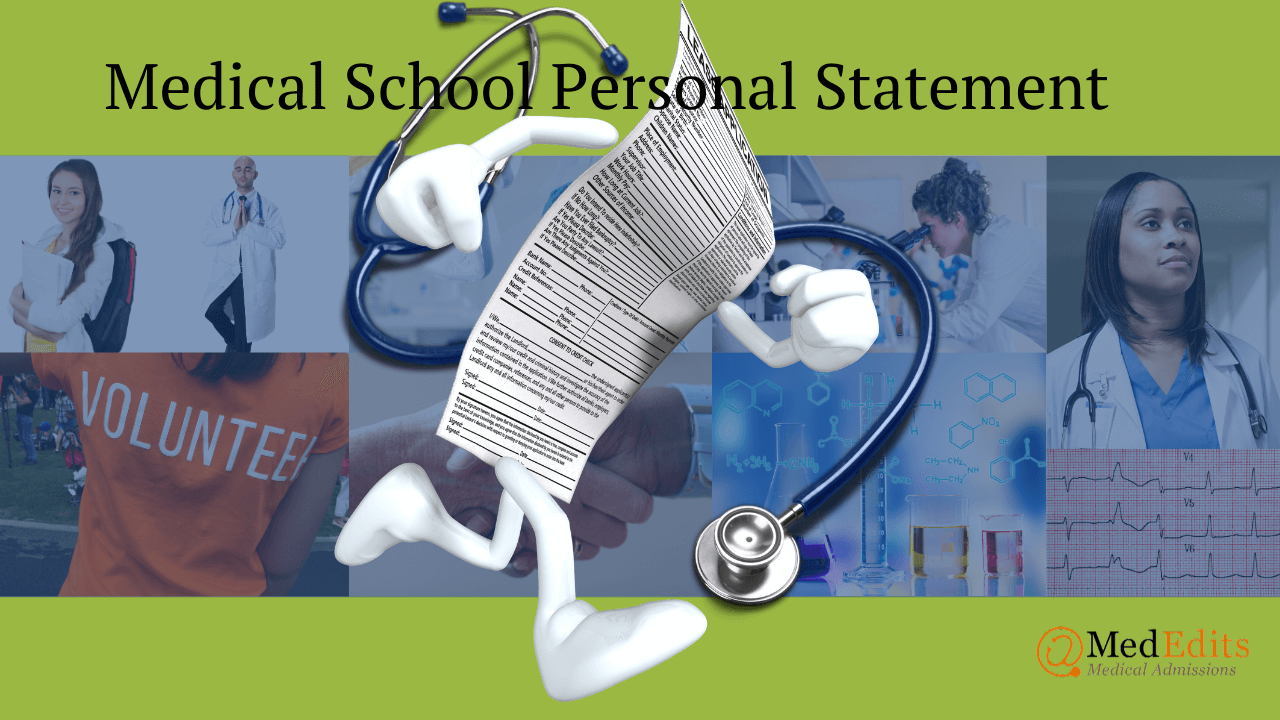
A physician and former medical school admissions officer teaches you how to write your medical school personal statement, step by step. Read several full-length medical school personal statement examples for inspiration.
In this article, a former medical school admissions officer explains exactly how to write a stand-out medical school personal statement!
Our goal is to empower you to write a medical school personal statement that reflects your individuality, truest aspirations and genuine motivations.
This guide also includes:
- Real life medical school personal statement examples
- Medical school personal statement inventory template and outline exercise
- AMCAS , TMDSAS , and AACOMAS personal statement prompts
- Advanced strategies to ensure you address everything admissions committees want to know
- The secret to writing a great medical school personal statement
So, if you want your medical school personal statement to earn more more medical school interviews, you will love this informative guide.
Let’s dive right in.
Table of Contents
Medical School Personal Statement Fundamentals
If you are getting ready to write your medical school personal statement for the 2024-2025 application year, you may already know that almost 60% of medical school applicants are not accepted every year . You have most likely also completed all of your medical school requirements and have scoured the internet for worthy medical school personal statement examples and guidance.
You know the medical school personal statement offers a crucial opportunity to show medical schools who you are beyond your GPA and MCAT score .
It provides an opportunity to express who you are as an individual, the major influences and background that have shaped your interests and values, what inspired you to pursue medicine, and what kind of a physician you envision yourself becoming.
However, with so much information online, you are not sure who to trust. We are happy you have found us!

Insider Knowledge and Expertise
Because the vast majority of people offering guidance are not former admissions officers or doctors , you must be careful when searching online.
We are real medical school admissions insiders and know what goes on behind closed doors and how to ensure your medical school personal statement has broad appeal while highlighting your most crucial accomplishments, perspectives, and insights.
With tight limits on space, it can be tough trying to decide what to include in your medical school personal statement to make sure you stand out. You must think strategically about how you want to present your personal “big picture” while showing you possess the preprofessional competencies med schools are seeking.
When a medical school admissions reviewer finishes reading your medical school personal statement, ask yourself:
- What are the most important things you want that person to remember about you?
- Does your medical school personal statement sum up your personality, interests, and talents?
- Does your medical school personal statement sound as if it’s written from the heart? Is it authentic?
It’s pretty obvious to most admissions reviewers when applicants are trying too hard to impress them. Being authentic and upfront about who you are is the best way to be a memorable applicant.
“After sitting on a medical school admissions committee for many years, I can tell you, think strategically about how you want to present your personal “big picture.” We want to know who you are as a human being.”
The Biggest Medical School Personal Statement Mistakes
The most common medical school personal statement mistake we see students make is that they write about:
- What they have accomplished
- How they have accomplished it
By including details on what you have accomplished and how, you will make yourself sound like every other medical school applicant.
Most medical school applicants are involved in similar activities: research, clinical work, service, and social justice work.
To stand out, you must write from the heart making it clear you haven’t marched through your premedical years and checking boxes.
We also strongly discourage applicants from using ChatGPT or any AI bot to write their medical school personal statement. Writing in your own voice is essential and using anything automated will undermine success.
The Medical School Personal Statement Secret
MedEdits students stand out in the medical school personal statement because in their personal statements they address:
WHY they have accomplished what they have.
In other words, they write in more detail about their passions, interests, and what is genuinely important to them.
It sounds simple, we know, but by writing in a natural way, really zeroing in on WHY YOU DO WHAT YOU DO, you will appeal to a wide variety of people in a humanistic way.
Why? How is that possible? They all have a few things in common:
- They write a narrative that is authentic and distinctive to them.
- They write a medical school personal statement with broad appeal (many different types of people will be evaluating your application; most are not physicians).
- They don’t try too hard to impress; instead they write about the most impactful experiences they have had on their path to medical school.
- They demonstrate they are humble, intellectual, compassionate, and committed to a career in medicine all at the same time.
Keep reading for a step by step approach to write your medical school personal statement.
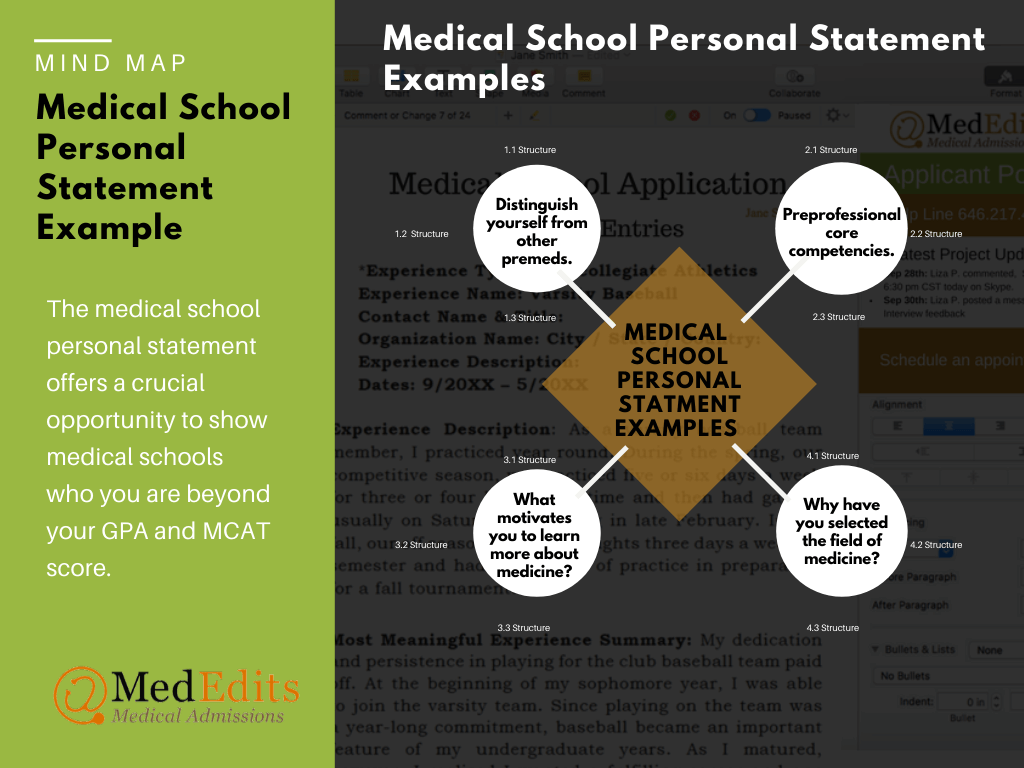
Learn the 2024-2025 Medical School Personal Statement Prompts ( AMCAS , TMDSAS , AACOMAS )
The personal statement is the major essay portion of your primary application process. In it, you should describe yourself and your background, as well as any important early exposures to medicine, how and why medicine first piqued your interest, what you have done as a pre med, your personal experiences, and how you became increasingly fascinated with it. It’s also key to explain why medicine is the right career for you, in terms of both personal and intellectual fulfillment, and to show your commitment has continued to deepen as you learned more about the field.
The personal statement also offers you the opportunity to express who you are outside of medicine. What are your other interests? Where did you grow up? What did you enjoy about college? Figuring out what aspects of your background to highlight is important since this is one of your only chances to express to the med school admissions committee before your interview what is important to you and why.
However, it is important to consider the actual personal statement prompt for each system through which you will apply, AMCAS, AACOMAS, and TMDSAS, since each is slightly different.
Need help with your Personal Statement?
Schedule a free 15 Minute Consultation with a MedEdits expert.
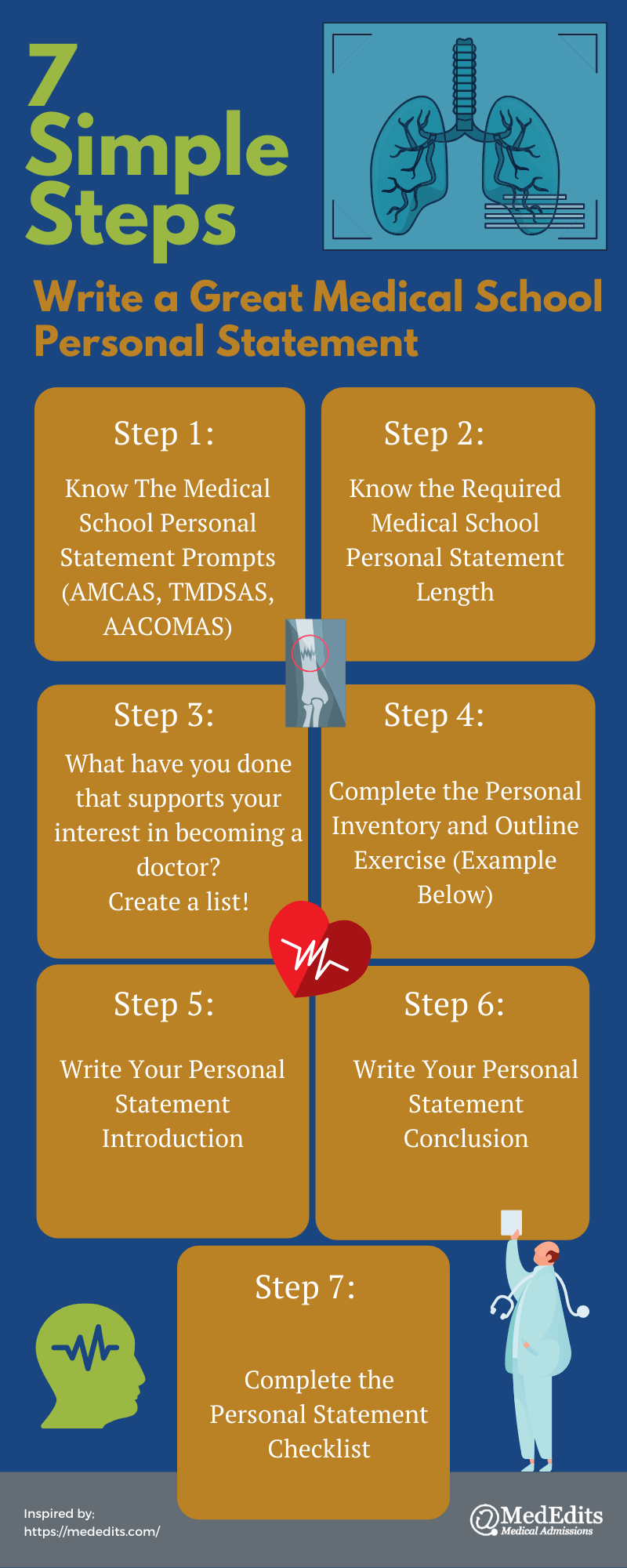
2024 AMCAS Personal Statement Prompt

The AMCAS personal statement instructions are as follows:
Use the Personal Comments Essay as an opportunity to distinguish yourself from other applicants. Consider and write your Personal Comments Essay carefully; many admissions committees place significant weight on the essay. Here are some questions that you may want to consider while writing the essay:
- Why have you selected the field of medicine?
- What motivates you to learn more about medicine?
- What do you want medical schools to know about you that hasn’t been disclosed in other sections of the application?
In addition, you may wish to include information such as:
- Unique hardships, challenges, or obstacles that may have influenced your educational pursuits
- Comments on significant fluctuations in your academic record that are not explained elsewhere in your application
As you can see, these prompts are not vague; there are fundamental questions that admissions committees want you to answer when writing your personal statement. While the content of your statement should be focused on medicine, answering the open ended third question is a bit trickier.
The AMCAS personal statement length is 5,300 characters with spaces maximum.
2024 TMDSAS Personal Statement Prompt

The TMDSAS personal statement is one of the most important pieces of your medical school application.
The TMDSAS personal statement prompt is as follows:
Explain your motivation to seek a career in medicine. Be sure to include the value of your experiences that prepare you to be a physician.
This TMDSAS prompt is very similar to the AMCAS personal statement prompt. The TMDSAS personal statement length is 5,000 characters with spaces whereas the AMCAS personal statement length is 5,300 characters with spaces. Most students use the same essay (with very minor modifications, if necessary) for both application systems.
2024 AACOMAS Personal Statement Prompt
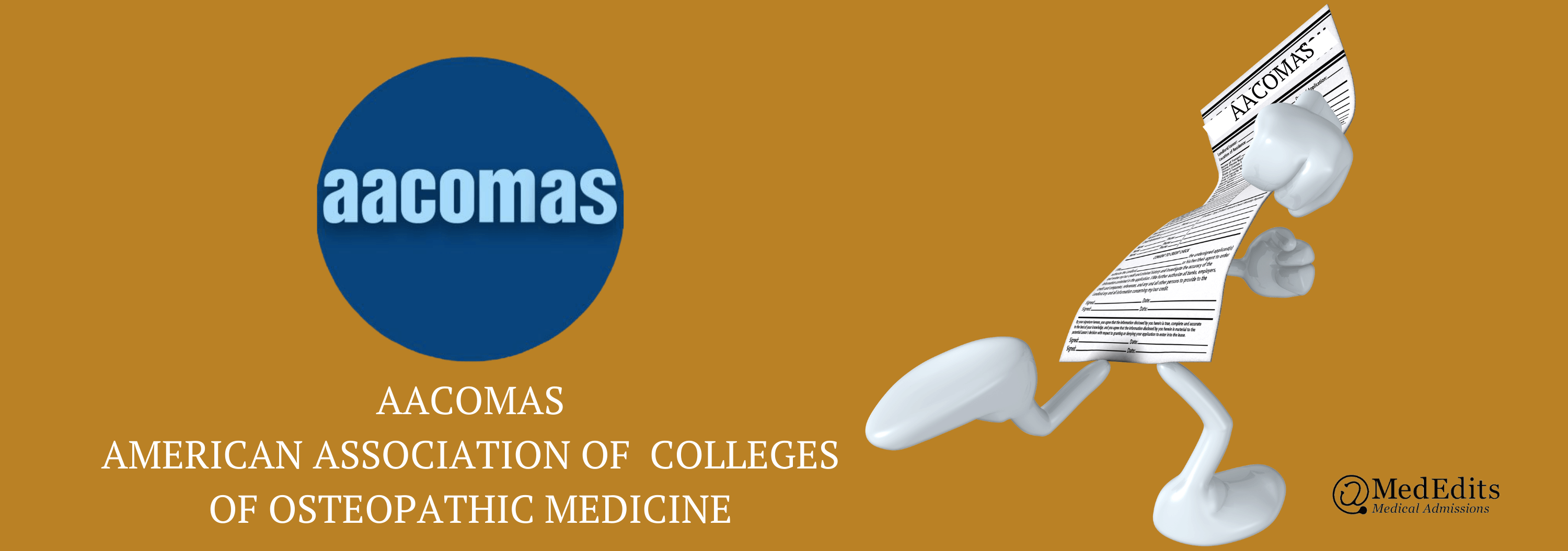
The AACOMAS personal statement is for osteopathic medical schools specifically. As with the AMCAS statement, you need to lay out your journey to medicine as chronologically as possible in 5,300 characters with spaces or less. So you essentially have the same story map as for an AMCAS statement. Most important, you must show you are interested in osteopathy specifically. Therefore, when trying to decide what to include or leave out, prioritize any osteopathy experiences you have had, or those that are in line with the osteopathic philosophy of the mind-body connection, the body as self-healing, and other tenets.
Medical School Application Timeline and When to Write your Personal Statement
Most medical school personal statements can be used for AMCAS and AACOMAS.
Know the Required Medical School Personal Statement Length
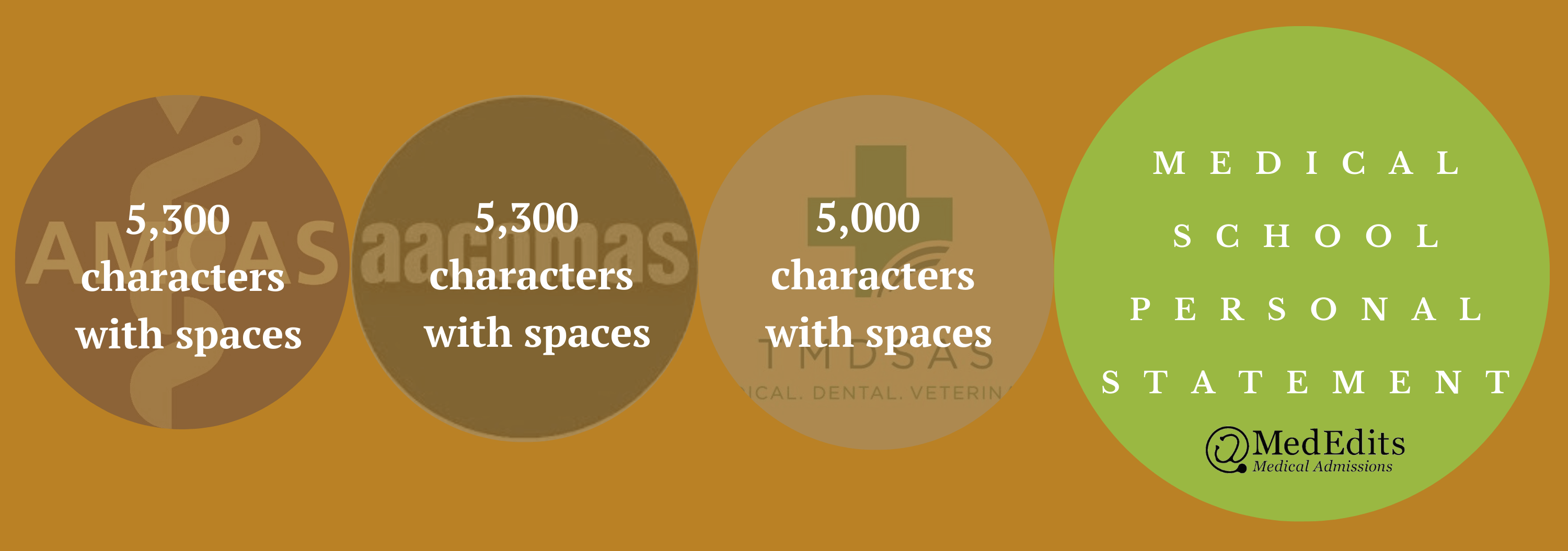
Below are the medical schools personal statement length limits for each application system. As you can see, they are all very similar. When you start brainstorming and writing your personal statement, keep these limits in mind.
AMCAS Personal Statement Length : 5,300 characters with spaces.
As per the AAMC website : “The available space for this essay is 5,300 characters (spaces are counted as characters), or approximately one page. You will receive an error message if you exceed the available space.”
AACOMAS Personal Statement Length : 5,300 characters with spaces
TMDSAS Personal Statement Length : 5,000 characters with spaces
As per the TMDSAS Website (Page 36): “The personal essay asks you to explain your motivation to seek a career in medicine. You are asked to include the value of your experiences that prepare you to be a physician. The essay is limited to 5000 characters, including spaces.”
- Service Orientation
- Social Skills
- Cultural Competence
- Oral Communication
- Ethical Responsibility to Self and Others
- Reliability and Dependability
- Resilience and Adaptability
- Capacity for Improvement
- Critical Thinking
- Quantitative Reasoning
- Written Communication
- Scientific Inquiry
2. Why do you want to be a doctor?
This may seem pretty basic – and it is – but admissions officers need to know WHY you want to practice medicine. Many applicants make the mistake of simply listing what they have done without offering insights about those experiences that answer the question, “Why medicine?” Your reasons for wanting to be a doctor may overlap with those of other applicants. This is okay because the experiences in which you participated, the stories you can tell about those experiences, and the wisdom you gained are completely distinct—because they are only yours.
“In admissions committee meetings we were always interested in WHY you wanted to earn a medical degree and how you would contribute to the medical school community.”
Medical school admissions committees want to know that you have explored your interest deeply and that you can reflect on the significance of these clinical experiences and volunteer work. But writing only that you “want to help people” does not support a sincere desire to become a physician; you must indicate why the medical profession in particular—rather than social work, teaching, or another “helping” profession—is your goal.
3. How have your experiences influenced you?
It is important to show how your experiences are linked and how they have influenced you. What motivated you from your experiences? In what ways did they influence your other activities? How were your future goals shaped by these experiences? Medical school admissions committees like to see a sensible progression of involvements. While not every activity needs to be logically “connected” with another, the evolution of your interests and how your experiences have nurtured your future goals and ambitions show that you are motivated and committed.
4. Who are you as a person? What are your values and ideals?
Medical school admissions committees want to know about you as an individual beyond your interests in medicine, too. This is where answering that third open ended question in the prompt becomes so important. What was interesting about your background, youth, and home life? What did you enjoy most about college? Do you have any distinctive passions or interests? They want to be convinced that you are a good person beyond your experiences. Write about those topics that are unlikely to appear elsewhere in your statement that will offer depth and interest to your work and illustrate the qualities and characteristics you possess.
Related Articles:
- How to Get into Stanford Medical School
- How to Get into NYU Medical School
- How To Get Into Columbia Medical School
- How To Get Into UT Southwestern Medical School
- How To Get Into Harvard Medical School
Complete Your Personal Inventory and Outline (Example Below)
Highlighting valuable experiences, experience-based personal inventory exercise, creating your personal inventory.
- List Important Experiences: Write down a list of the most important experiences in your life and your development. The list should be all-inclusive and comprise those experiences that had the most impact on you. Put the list, which should consist of personal, extracurricular, and academic events, in chronological order.
- Identify Key Experiences: From this list, determine which experiences you consider the most important in helping you decide to pursue a career in medicine. This “experience-oriented” approach will allow you to determine which experiences best illustrate the personal competencies admissions committees look for in your written documents. Remember that you must provide evidence for your interest in medicine and for most of the personal qualities and characteristics that medical school admissions committees want to see.
- Reflect on Influences: After making your list, think about why each “most important” experience was influential and write that down. What did you observe? What did you learn? What insights did you gain? How did the experience influence your path and choices?
- Create Illustrations: Then think of a story or illustration for why each experience was important.
- Evaluate for Significance: After doing this exercise, evaluate each experience for its significance and influence and for its “story” value. Choose to write about those experiences that not only were influential but that also will provide interesting reading, keeping in mind that your goal is to weave the pertinent experiences together into a compelling story. In making your choices, think about how you will link each experience and transition from one topic to the next.
- Plan Your Outline: Decide which of your listed experiences you will use for your introduction first (see below for more about your introduction). Then decide which experiences you will include in the body of your personal statement, create a general outline, and get writing!
Crafting Your Narrative
Craft a compelling personal statement introduction and body.
You hear conflicting advice about application essays. Some tell you not to open with a story. Others tell you to always begin with a story. Regardless of the advice you receive, be sure to do three things:
- Be true to yourself. Everyone will have an opinion regarding what you should and should not write. Follow your own instincts. Your personal statement should be a reflection of you, and only you.
- Start your personal statement with something catchy. Think about the list of potential topics above.
- Don’t rush your work. Composing thoughtful documents takes time and you don’t want your writing and ideas to be sloppy and underdeveloped.
Most important is to begin with something that engages your reader. A narrative, a “story,” an anecdote written in the first or third person, is ideal. Whatever your approach, your first paragraph must grab your reader’s attention and motivate him to want to continue reading. I encourage applicants to start their personal statement by describing an experience that was especially influential in setting them on their path to medical school. This can be a personal or scholarly experience or an extracurricular one. Remember to avoid clichés and quotes and to be honest and authentic in your writing. Don’t try to be someone who you are not by trying to imitate personal statement examples you have read online or “tell them what you think they want to hear”; consistency is key and your interviewer is going to make sure that you are who you say you are!
When deciding what experiences to include in the body of your personal statement, go back to your personal inventory and identify those experiences that have been the most influential in your personal path and your path to medical school. Keep in mind that the reader wants to have an idea of who you are as a human being so don’t write your personal statement as a glorified resume. Include some information about your background and personal experiences that can give a picture of who you are as a person outside of the classroom or laboratory.
Ideally, you should choose two or three experiences to highlight in the body of your personal statement. You don’t want to write about all of your accomplishments; that is what your application entries are for!
Write Your Personal Statement Conclusion
In your conclusion, it is customary to “go full circle” by coming back to the topic—or anecdote—you introduced in the introduction, but this is not a must. Summarize why you want to be a doctor and address what you hope to achieve and your goals for medical school. Write a conclusion that is compelling and will leave the reader wanting to meet you.
Complete Personal Statement Checklist
When reading your medical school personal statement be sure it:
Shows insight and introspection
The best medical school personal statements tell a great deal about what you have learned through your experiences and the insights you have gained.
You want to tell your story by highlighting those experiences that have been the most influential on your path to medical school and to give a clear sense of chronology. You want your statement always to be logical and never to confuse your reader.
Is interesting and engaging
The best personal statements engage the reader. This doesn’t mean you must use big words or be a literary prize winner. Write in your own language and voice, but really think about your journey to medical school and the most intriguing experiences you have had.
Gives the reader a mental image of who you are
You want the reader to be able to envision you as a caregiver and a medical professional. You want to convey that you would be a compassionate provider at the bedside – someone who could cope well with crisis and adversity.
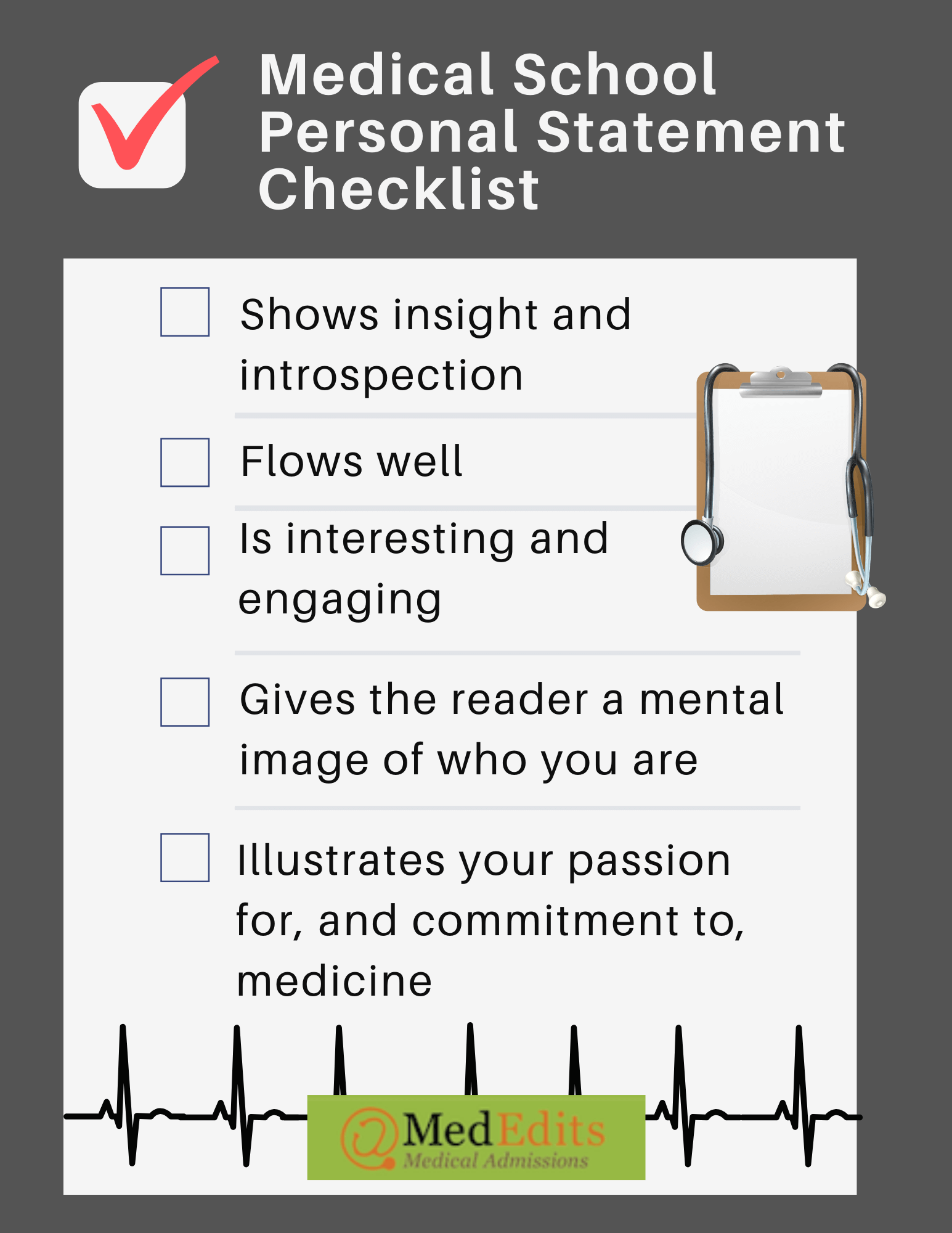
Not true. The vast majority of personal statements do not have themes. In fact, most are somewhat autobiographical and are just as interesting as those statements that are woven around a “theme.” It is only the very talented writer who can creatively write a personal statement around a theme, and this approach often backfires since the applicant fails to answer the three questions above.
Medical School Personal Statement Examples and Analysis for Inspiration
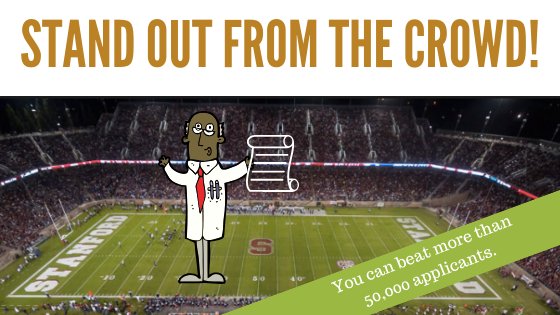
AMCAS Medical School Personal Statement Example and Analysis #1 with Personal Inventory
We will use Amy to illustrate the general process of writing an application to medical school, along with providing the resulting documents. Amy will first list those experiences, personal, extracurricular, and scholarly, that have been most influential in two areas: her life in general and her path to medical school. She will put this personal inventory in chronologic order for use in composing her personal statement.
She will then select those experiences that were the most significant to her and will reflect and think about why they were important. For her application entries, Amy will write about each experience, including those that she considers influential in her life but not in her choice of medicine, in her application entries. Experiences that Amy will not write about in her activity entries or her personal statement are those that she does not consider most influential in either her life or in her choice of medicine.
- Going with my mom to work. She is a surgeon — I was very curious about what she did. I was intrigued by the relationships she had with patients and how much they valued her efforts. I also loved seeing her as “a doctor” since, to me, she was just “mom.”
- I loved biology in high school. I started to think seriously about medicine then. It was during high school that I became fascinated with biology and how the human body worked. I would say that was when I thought, “Hmm, maybe I should be a doctor.”
- Grandmother’s death, senior year of high school. My grandmother’s death was tragic. It was the first time I had ever seen someone close to me suffer. It was one of the most devastating experiences in my life.
- Global Health Trip to Guatemala my freshman year of college. I realized after going to Guatemala that I had always taken my access to health care for granted. Here I saw children who didn’t have basic health care. This made me want to become a physician so I could give more to people like those I met in Guatemala.
- Sorority involvement. Even though sorority life might seem trivial, I loved it. I learned to work with different types of people and gained some really valuable leadership experience.
- Poor grades in college science classes. I still regret that I did badly in my science classes. I think I was immature and was also too involved in other activities and didn’t have the focus I needed to do well. I had a 3.4 undergraduate GPA.
- Teaching and tutoring Jose, a child from Honduras. In a way, meeting Jose in a college tutoring program brought my Guatemala experience to my home. Jose struggled academically, and his parents were immigrants and spoke only Spanish, so they had their own challenges. I tried to help Jose as much as I could. I saw that because he lacked resources, he was at a tremendous disadvantage.
- Volunteering at Excellent Medical Center. Shadowing physicians at the medical center gave me a really broad view of medicine. I learned about different specialties, met many different patients, and saw both great and not-so-great physician role models. Counselor at Ronald McDonald House. Working with sick kids made me appreciate my health. I tried to make them happy and was so impressed with their resilience. It made me realize that good health is everything.
- Oncology research. Understanding what happens behind the scenes in research was fascinating. Not only did I gain some valuable research experience, but I learned how research is done.
- Peer health counselor. Communicating with my peers about really important medical tests gave me an idea of the tremendous responsibility that doctors have. I also learned that it is important to be sensitive, to listen, and to be open-minded when working with others.
- Clinical Summer Program. This gave me an entirely new view of medicine. I worked with the forensics department, and visiting scenes of deaths was entirely new to me. This experience added a completely new dimension to my understanding of medicine and how illness and death affect loved ones.
- Emergency department internship. Here I learned so much about how things worked in the hospital. I realized how important it was that people who worked in the clinical department were involved in creating hospital policies. This made me understand, in practical terms, how an MPH would give me the foundation to make even more change in the future.
- Master’s in public health. I decided to get an MPH for two reasons. First of all, I knew my undergraduate science GPA was an issue so I figured that graduate level courses in which I performed well would boost my record. I don’t think I will write this on my application, but I also thought the degree would give me other skills if I didn’t get into medical school, and I knew it would also give me something on which I could build during medical school and in my career since I was interested in policy work.
As you can see from Amy’s personal inventory list, she has many accomplishments that are important to her and influenced her path. The most influential personal experience that motivated her to practice medicine was her mother’s career as a practicing physician, but Amy was also motivated by watching her mother’s career evolve. Even though the death of her grandmother was devastating for Amy, she did not consider this experience especially influential in her choice to attend medical school so she didn’t write about it in her personal statement.
Amy wrote an experience-based personal statement, rich with anecdotes and detailed descriptions, to illustrate the evolution of her interest in medicine and how this motivated her to also earn a master’s in public health.
Amy’s Medical School Personal Statement Example:
She was sprawled across the floor of her apartment. Scattered trash, decaying food, alcohol bottles, medication vials, and cigarette butts covered the floor. I had just graduated from college, and this was my first day on rotation with the forensic pathology department as a Summer Scholar, one of my most valuable activities on the path to medical school. As the coroner deputy scanned the scene for clues to what caused this woman’s death, I saw her distraught husband. I did not know what to say other than “I am so sorry.” I listened intently as he repeated the same stories about his wife and his dismay that he never got to say goodbye. The next day, alongside the coroner as he performed the autopsy, I could not stop thinking about the grieving man.
Discerning a cause of death was not something I had previously associated with the practice of medicine. As a child, I often spent Saturday mornings with my mother, a surgeon, as she rounded on patients. I witnessed the results of her actions, as she provided her patients a renewed chance at life. I grew to honor and respect my mother’s profession. Witnessing the immense gratitude of her patients and their families, I quickly came to admire the impact she was able to make in the lives of her patients and their loved ones.
I knew I wanted to pursue a career in medicine as my mother had, and throughout high school and college I sought out clinical, research, and volunteer opportunities to gain a deeper understanding of medicine. After volunteering with cancer survivors at Camp Ronald McDonald, I was inspired to further understand this disease. Through my oncology research, I learned about therapeutic processes for treatment development. Further, following my experience administering HIV tests, I completed research on point-of-care HIV testing, to be instituted throughout 26 hospitals and clinics. I realized that research often served as a basis for change in policy and medical practice and sought out opportunities to learn more about both.
All of my medically related experiences demonstrated that people who were ‘behind the scenes’ and had limited or no clinical background made many of the decisions in health care. Witnessing the evolution of my mother’s career further underscored the impact of policy change on the practice of medicine. In particular, the limits legislation imposed on the care she could provide influenced my perspective and future goals. Patients whom my mother had successfully treated for more than a decade, and with whom she had long-standing, trusting relationships, were no longer able to see her, because of policy coverage changes. Some patients, frustrated by these limitations, simply stopped seeking the care they needed. As a senior in college, I wanted to understand how policy transformations came about and gain the tools I would need to help effect administrative and policy changes in the future as a physician. It was with this goal in mind that I decided to complete a master’s in public health program before applying to medical school.
As an MPH candidate, I am gaining insight into the theories and practices behind the complex interconnections of the healthcare system; I am learning about economics, operations, management, ethics, policy, finance, and technology and how these entities converge to impact delivery of care. A holistic understanding of this diverse, highly competitive, market-driven system will allow me, as a clinician, to find solutions to policy, public health, and administration issues. I believe that change can be more effective if those who actually practice medicine also decide where improvements need to be made.
For example, as the sole intern for the emergency department at County Medical Center, I worked to increase efficiency in the ED by evaluating and mapping patient flow. I tracked patients from point of entry to point of discharge and found that the discharge process took up nearly 35% of patients’ time. By analyzing the reasons for this situation, in collaboration with nurses and physicians who worked in the ED and had an intimate understanding of what took place in the clinical area, I was able to make practical recommendations to decrease throughput time. The medical center has already implemented these suggestions, resulting in decreased length of stays. This example illustrates the benefit of having clinicians who work ‘behind the scenes’ establish policies and procedures, impacting operational change and improving patient care. I will also apply what I have learned through this project as the business development intern at Another Local Medical Center this summer, where I will assist in strategic planning, financial analysis, and program reviews for various clinical departments.
Through my mother’s career and my own medical experiences, I have become aware of the need for clinician administrators and policymakers. My primary goal as a physician will be to care for patients, but with the knowledge and experience I have gained through my MPH, I also hope to effect positive public policy and administrative changes.
Paragraphs 1 and 2: Amy started her personal statement by illustrating a powerful experience she had when she realized that medical caregivers often feel impotent, and how this contrasted with her understanding of medicine as a little girl going with her mother to work. Recognition of this intense contrast also highlights her maturity.
P-3: She then “lists” a few experiences that were important to her.
Paragraph 4: Amy describes the commonality in some of her experiences and how her observations were substantiated by watching the evolution of her mother’s practice. She then explains how this motivated her to earn an MPH so she could create change more effectively as a physician than as a layman.
P-5: Next, she explains how her graduate degree is helping her to better understand the “issues in medicine” that she observed.
Paragraph 6: Then, an exceptional accomplishment is described, highlighting what she has learned and how she has applied it.
P-7: Finally, she effectively concludes her personal statement and summarizes the major topics addressed in her essay.
As you can see, her statement has excellent flow, is captivating and unusual, and illustrates her understanding of, and commitment to, medicine. Throughout her application entries and statement, she exhibits the personal competencies, characteristics, and qualities that medical school admissions officers are seeking. Her application also has broad appeal; reviewers who are focused on research, cultural awareness, working with the underserved, health administration and policy, teaching, or clinical medicine would all find it of interest.
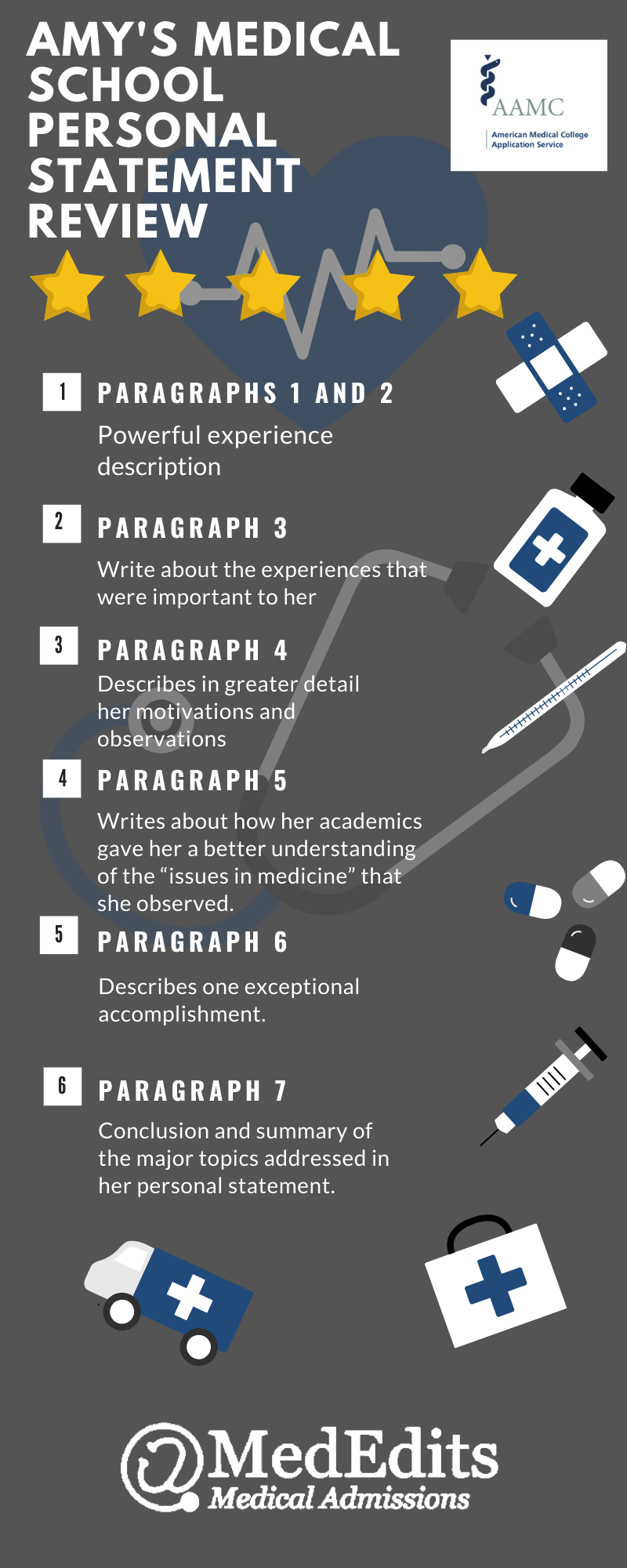
Osteopathic Medical School Personal Statement
Example and Analysis #2
Medical School Personal Statement Example Background: This is a nontraditional applicant who applied to osteopathic medical schools. With a 500 and a 504 on the MCAT , he needed to showcase how his former career and what he learned through his work made him an asset. He also needed to convey why osteopathic medicine was an ideal fit for him. The student does an excellent job illustrating his commitment to medicine and explaining why and how he made the well-informed decision to leave his former career to pursue a career in osteopathic medicine.
What’s Good About It: A nontraditional student with a former career, this applicant does a great job outlining how and why he decided to pursue a career in medicine. Clearly dedicated to service, he also does a great job making it clear he is a good fit for osteopathic medical school and understands this distinctions of osteopathic practice..
Working as a police officer, one comes to expect the unexpected, but sometimes, when the unexpected happens, one can’t help but be surprised. In November 20XX, I had been a police officer for two years when my partner and I happened to be nearby when a man had a cardiac emergency in Einstein Bagels. Entering the restaurant, I was caught off guard by the lifeless figure on the floor, surrounded by spilled food. Time paused as my partner and I began performing CPR, and my heart raced as I watched color return to the man’s pale face.
Luckily, paramedics arrived within minutes to transport him to a local hospital. Later, I watched as the family thanked the doctors who gave their loved one a renewed chance at life. That day, in the “unexpected,” I confirmed that I wanted to become a physician, something that had attracted me since childhood.
I have always been enthralled by the science of medicine and eager to help those in need but, due to life events, my path to achieving this dream has been long. My journey began following high school when I joined the U.S. Army. I was immature and needed structure, and I knew the military was an opportunity to pursue my medical ambitions. I trained as a combat medic and requested work in an emergency room of an army hospital. At the hospital, I started IVs, ran EKGs, collected vital signs, and assisted with codes. I loved every minute as I was directly involved in patient care and observed physicians methodically investigating their patients’ signs and symptoms until they reached a diagnosis. Even when dealing with difficult patients, the physicians I worked with maintained composure, showing patience and understanding while educating patients about their diseases. I observed physicians not only as clinicians but also as teachers. As a medic, I learned that I loved working with patients and being part of the healthcare team, and I gained an understanding of acute care and hospital operations.
Following my discharge in 20XX, I transferred to an army reserve hospital and continued as a combat medic until 20XX. Working as a medic at several hospitals and clinics in the area, I was exposed to osteopathic medicine and the whole body approach to patient care. I was influenced by the D.O.s’ hands-on treatment and their use of manipulative medicine as a form of therapy. I learned that the body cannot function properly if there is dysfunction in the musculoskeletal system.
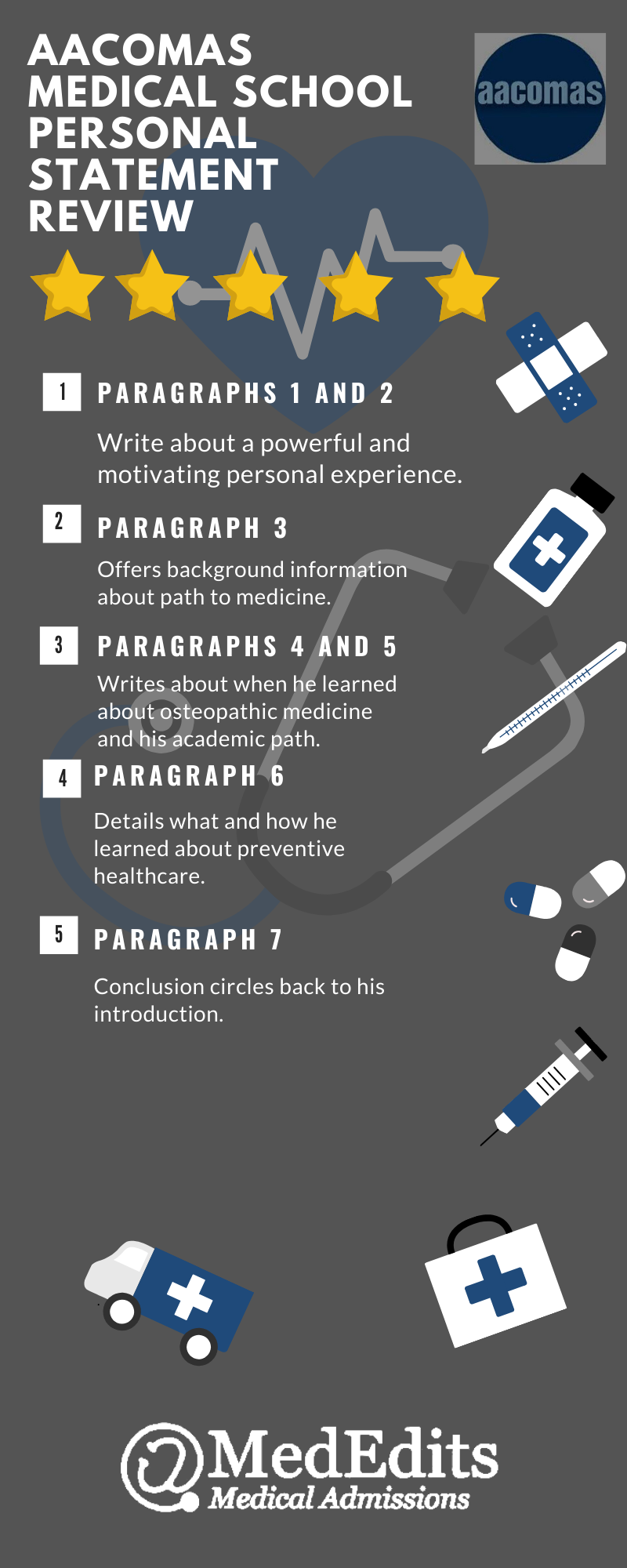
In 20XX, I became a police officer to support myself as I finished my undergraduate degree and premed courses. While working the streets, I continued my patient care experiences by being the first to care for victims of gunshot wounds, stab wounds, car accidents, and other medical emergencies. In addition, I investigated many unknown causes of death with the medical examiner’s office. I often found signs of drug and alcohol abuse and learned the dangers and power of addiction. In 20XX, I finished my undergraduate degree in education and in 20XX, I completed my premed courses.
Wanting to learn more about primary care medicine, in 20XX I volunteered at a community health clinic that treats underserved populations. Shadowing a family physician, I learned about the physical exam as I looked into ears and listened to the hearts and lungs of patients with her guidance. I paid close attention as she expressed the need for more PCPs and the important roles they play in preventing disease and reducing ER visits by treating and educating patients early in the disease process. This was evident as numerous patients were treated for high cholesterol, elevated blood pressure, and diabetes, all conditions that can be resolved or improved by lifestyle changes. I learned that these changes are not always easy for many in underserved populations as healthier food is often more expensive and sometimes money for prescriptions is not available. This experience opened my eyes to the challenges of being a physician in an underserved area.
The idea of disease prevention stayed with me as I thought about the man who needed CPR. Could early detection and education about heart disease have prevented his “unexpected” cardiac event? My experiences in health care and law enforcement have confirmed my desire to be an osteopathic physician and to treat the patients of the local area. I want to eliminate as many medical surprises as I can.

Texas Medical School Personal Statement Example and Analysis #3
Medical School Personal Statement Example Background: This applicant, who grew up with modest means, should be an inspiration to us all. Rather than allowing limited resources to stand in his way, he took advantage of everything that was available to him. He commuted to college from home and had a part-time job so he was stretched thin, and his initial college performance suffered. However, he worked hard and his grades improved. Most medical school admissions committees seek out applicants like this because, by overcoming adversity and succeeding with limited resources, they demonstrate exceptional perseverance, maturity, and dedication. His accomplishments are, by themselves, impressive and he does an outstanding job of detailing his path, challenges, and commitment to medicine. He received multiple acceptances to top medical schools and was offered scholarships.
What’s Good About It: This student does a great job opening his personal statement with a beautifully written introduction that immediately takes the reader to Central America. He then explains his path, why he did poorly early in college, and goes on to discuss his academic interests and pursuits. He is also clearly invested in research and articulates that he is intellectually curious, motivated, hard working, compassionate and committed to a career in medicine by explaining his experiences using interesting language and details. This is an intriguing statement that makes clear the applicant is worthy of an interview invitation. Finally, the student expresses his interest in attending medical school in Texas.
They were learning the basics of carpentry and agriculture. The air was muggy and hot, but these young boys seemed unaffected, though I and my fellow college students sweated and often complained. As time passed, I started to have a greater appreciation for the challenges these boys faced. These orphans, whom I met and trained in rural Central America as a member of The Project, had little. They dreamed of using these basic skills to earn a living wage. Abandoned by their families, they knew this was their only opportunity to re-enter society as self- sufficient individuals. I stood by them in the fields and tutored them after class. And while I tried my best to instill in them a strong work ethic, it was the boys who instilled in me a desire to help those in need. They gave me a new perspective on my decision to become a doctor.
I don’t know exactly when I decided to become a physician; I have had this goal for a long time. I grew up in the inner city of A City, in Texas and attended magnet schools. My family knew little about higher education, and I learned to seek out my own opportunities and advice. I attended The University with the goal of gaining admission to medical school. When I started college, I lacked the maturity to focus on academics and performed poorly. Then I traveled to Central America. Since I was one of the few students who spoke Spanish, many of the boys felt comfortable talking with me. They saw me as a role model.
The boys worked hard so that they could learn trades that would help them to be productive members of society. It was then I realized that my grandparents, who immigrated to the US so I would have access to greater opportunities, had done the same. I felt like I was wasting what they had sacrificed for me. When I returned to University in the fall, I made academics my priority and committed myself to learn more about medicine.
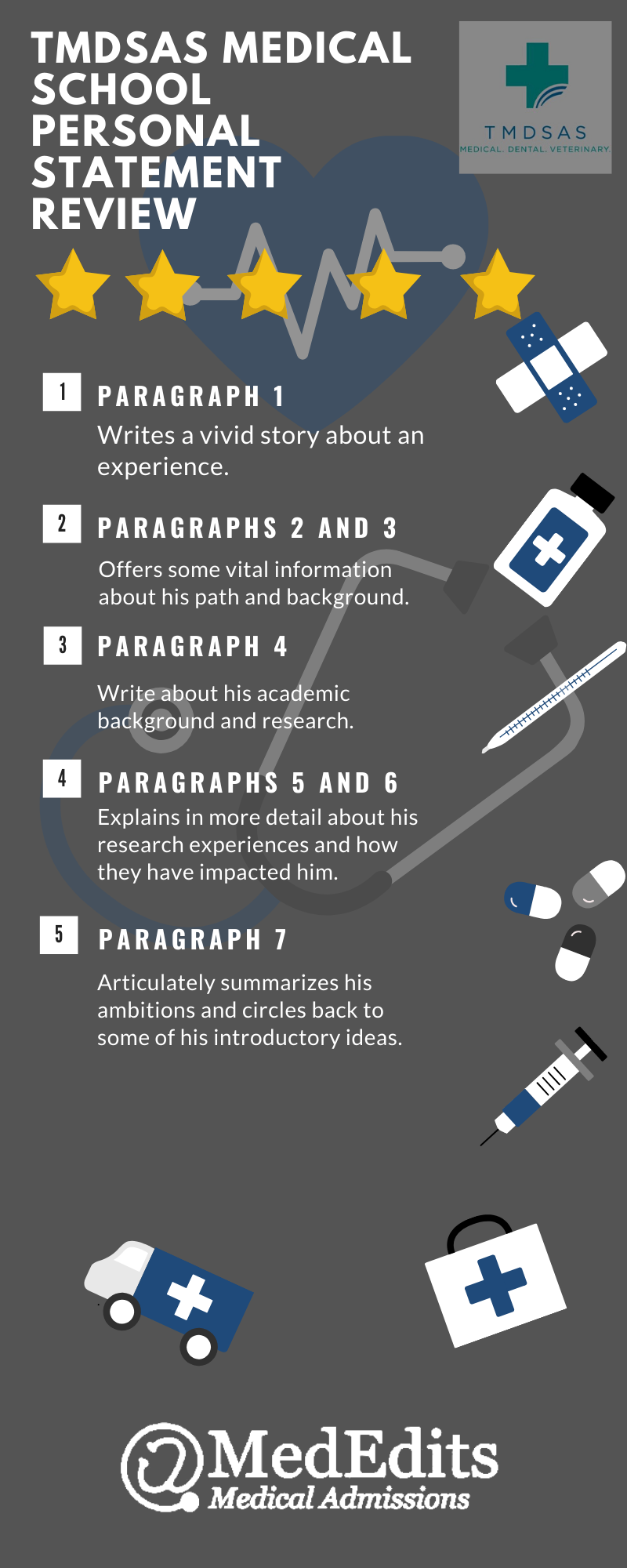
Through my major in neuroscience, I strengthened my understanding of how we perceive and experience life. In systems neurobiology, I learned the physiology of the nervous system. Teaching everything from basic neural circuits to complex sensory pathways, Professor X provided me with the knowledge necessary to conduct research in Parkinson’s disease. My research focused on the ability of antioxidants to prevent the onset of Parkinson’s, and while my project was only a pilot study at the time, Professor X encouraged me to present it at the National Research Conference. During my senior year, I developed the study into a formal research project, recruiting the help of professors of statistics and biochemistry.
Working at the School of Medicine reinforced my analytical skills. I spent my summer in the department of emergency medicine, working with the department chair, Dr. Excellent. Through Dr. Excellent’s mentorship, I participated in a retrospective study analyzing patient charts to determine the efficacy of D-dimer assays in predicting blood clots. The direct clinical relevance of my research strengthened my commitment and motivated my decision to seek out more clinical research opportunities.
A growing awareness of the role of human compassion in healing has also influenced my choice to pursue a career in medicine. It is something no animal model or cell culture can ever duplicate or rival. Working in clinical research has allowed me to see the selflessness of many physicians and patients and their mutual desire to help others. As a research study assistant in the department of surgery, I educate and enroll patients in clinical trials. One such study examines the role of pre-operative substance administration in tumor progression. Patients enrolled in this study underwent six weeks of therapy before having the affected organ surgically excised. Observing how patients were willing to participate in this research to benefit others helped me understand the resiliency of the human spirit.
Working in clinical trials has enabled me to further explore my passion for science, while helping others. Through my undergraduate coursework and participation in volunteer groups I have had many opportunities to solidify my goal to become a physician. As I am working, I sometimes think about my second summer in Central America. I recall how one day, after I had turned countless rows of soil in scorching heat, one of the boys told me that I was a trabajador verdadero—a true worker. I paused as I realized the significance of this comment. While the boy may not have been able to articulate it, he knew I could identify with him. What the boy didn’t know, however, was that had my grandparents not decided to immigrate to the US, I would not have the great privilege of seizing opportunities in this country and writing this essay today. I look forward to the next step of my education and hope to return home to Texas where I look forward to serving the communities I call home.
Final Thoughts
Medical school personal statement help & consulting.
If all this information has you staring at your screen like a deer in the headlights, you’re not alone. Writing a superb medical school personal statement can be a daunting task, and many applicants find it difficult to get started writing, or to express everything they want to say succinctly. That’s where MedEdits can help. You don’t have to have the best writing skills to compose a stand-out statement. From personal-statement editing alone to comprehensive packages for all your medical school application needs, we offer extensive support and expertise developed from working with thousands of successful medical school applicants. We can’t promise applying to medical school will be stress-free, but most clients tell us it’s a huge relief not to have to go it alone.
MedEdits offers personal statement consulting and editing. Our goal when working with students is to draw out what makes each student distinctive. How do we do this? We will explore your background and upbringing, interests and ideals as well as your accomplishments and activities. By helping you identify the most distinguishing aspects of who you are, you will then be able to compose an authentic and genuine personal statement in your own voice to capture the admissions committee’s attention so you are invited for a medical school interview. Our unique brainstorming methodology has helped hundreds of aspiring premeds gain acceptance to medical school.
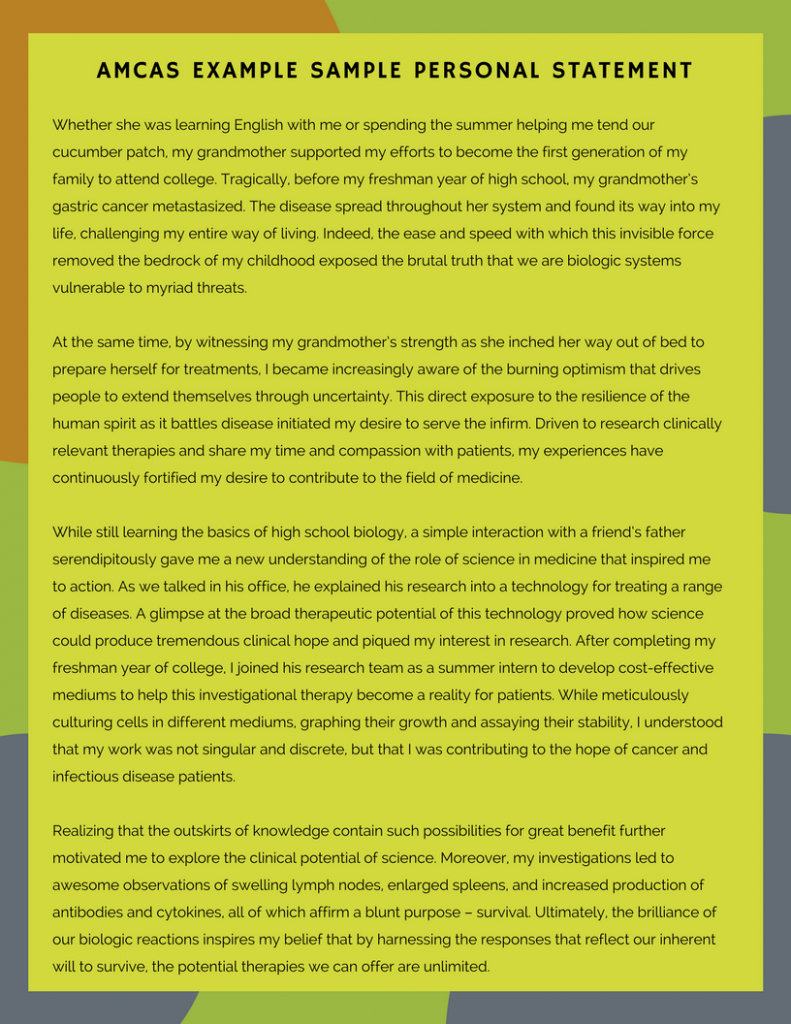
JESSICA FREEDMAN, M.D., is a former faculty member and admissions committee member at the Icahn School of Medicine at Mount Sinai. She is the founder and chair of MedEdits Medical Admissions and author of the MedEdits Guide to Medical Admissions and The Medical School Interview which you can find on Amazon . Follow Dr. Freedman and MedEdits on Facebook and YouTube.
- Website Disclaimer
- Terms and Conditions
- MedEdits Privacy Policy

- (888) 381-9509
- [email protected]
- Book a Meeting
- student login
- Student Login
- Our Services
- Our Story How it started
- Our Team Meet Our Advisors & Tutors
- Our Services How we can help you
- Our Difference Learn why we stand out
- Success Stories & Testimonials Hear the stories
- For Parents Learn why you should trust us
- In the News Read Our Stories
- Frequently Asked Questions Find answers
- MCAT Tutoring One-on-One Personalized Help
- MCAT Go An Audio Learning Experience
- MCAT Practice Exams Boost Your Score
- MCAT Prep App Videos, Flashcards & Q-Bank
- MCAT CARS Mastery Top-Rated CARS Video Course
- Pre-Med Coach Early High School Roadmap Planning
- College Admissions 11th & 12th Grade Pre-Med Consulting
- Direct Med Advising BS/MD Application Support
- Interview Preparation BS/MD Candidates
- Pre-Med Coach Pre-Application Development
- Application Advising Med School Admissions Support
- Personal Statement Editing Refine Your Narrative
- AMCAS Editing Application Editing
- Secondary Editing Secondary Application Editing
- Interview Preparation Realistic Practice
- CASPer Preparation Simulation & Coaching
- Ontario Application Support OMSAS Application
- Residency Advising Complete Match Support
- Residency Interview Preparation
- ERAS Personal Statement Refine Your Story
- USMLE STEP 1 Maximize your scores
- USMLE STEP 2 Shine on your boards
- USMLE STEP 3 Conquer your final hurdle
- COMLEX LEVEL 1 and 2 Score higher
- Institutional Partners Enhance your student offering
- Organizational Partners Provide value to your students
- Virtual Shadowing Explore Medical Specialties
- Extracurricular Activities Apply now!
- Under the Stethoscope Admissions Video Course
- Research Roadmap Master Clinical Research
- MSC Score Calculate Your Chances
- Guidebooks Comprehensive Guides
- Med School Explorer Find Your School
- MCAT Review Videos, Questions, Notes
The Only 3 Medical School Personal Statement Examples You Need to Read
Posted in: Applying to Medical School

Table of Contents
The personal statement is one of the most important parts of the med school application process because t his mini-essay is a critical opportunity for you to stand out from other prospective medical students by demonstrating your passion and personality, not just your grades.
Admissions committees receive hundreds or more AMCAS medical school applications , so yours should be unique and captivating. Your medical school personal statement shows admissions officers who you are beyond your high school or pre-med GPA , extracurriculars , and MCAT score .
The best personal statements are… well, personal . This is your chance to share what life experiences have compelled you toward a career in healthcare or the medical field , and how those experiences shape the picture of your ideal future.
MedSchoolCoach has crucial advice for writing your personal statement .
Read these examples of personal statements for prospective med students.
Writing a great medical school personal statement is a lot easier with the right support. We’ve helped numerous med school applicants craft top-notch personal statements and can do the same for you.
But first: 7 steps to writing an engaging personal statement.
Before you read these excellent examples, you need to understand the process of writing a personal statement.
Include these in your medical school personal statement:
- Why you’re passionate about becoming a doctor
- Your qualities that will make you a great physician
- Personal stories that demonstrate those qualities
- Specific examples of the communities you want to serve as a member of the medical field
What are the most important things to remember when writing a medical school personal statement ?
- Begin the writing process early: Give yourself plenty of time for brainstorming and to revisit your first draft, revising it based on input from family members and undergrad professors. Consult the application timeline for your target enrollment season.
- Choose a central theme: An unfocused essay will leave readers confused and uninterested. Give your statement a clear thesis in the first paragraph that guides its formation.
- Start with a hook: Grab the reader’s attention immediately with your statement’s first sentence. Instead of opening with a conventional introduction, be creative! Begin with something unexpected.
- Be the you of today, not the you of the future: Forecasting your future as a physician can come across as empty promises. Don’t get caught up in your ambitions; instead, be honest about your current situation and interest in the field of medicine.
- Demonstrate your passion: It’s not enough to simply state your interest in becoming a doctor; you have to prove it through personal stories. Show how your perspectives have been shaped by formative experiences and how those will make you an effective physician.
- Show, don’t tell : Avoid cliches that admissions committees have heard hundreds of times, like “I want to help people.” Make your writing come alive with dynamic, persuasive storytelling that recounts your personal experiences.
- Tie everything together: Conclude by wrapping up your main points. Reiterate your passion for the medical profession, your defining personal qualities, and why you’ll make a good doctor.
You can read more about our recommended method in our step-by-step guide , but those are the major points.
Example 1 — From the Stretcher to the Spotlight: My Journey to Becoming an Emergency Medicine Physician
Another siren shrieks as the emergency room doors slide open and a team of EMTs pushes a blood-soaked stretcher through the entrance. It’s the fifth ambulance to arrive tonight — and only my first clinical shadowing experience in an emergency medicine department since my premed education began.
But it wasn’t my first time in an emergency room, and I knew I was meant to be here again.
In those crucial moments on the ER floor, many of my peers learned that they stumble in high-pressure environments. A few weeks of gunshot wounds, drug overdoses, broken bones, and deep lacerations in the busiest trauma bay in the region were enough to alter their career path.
They will be better practitioners somewhere predictable, like a pediatrician in a private practice where they choose their schedules, clients, and staff.
Every healthcare provider has their specialties, and mine are on full display in those crucial moments of lifesaving care. Why am I pursuing a career in Emergency Medicine? Because I’ve seen firsthand the miracles that Emergency Medicine physicians perform.
12 years ago, I was in an emergency room… but I was the one on the stretcher.
A forest-green Saturn coupe rolled into my parent’s driveway. The driver, my best friend Kevin, had just passed his driving test and was itching to take a late-night run to the other side of town. I had ridden with Kevin and his father many times before when he held his learner’s permit. But this time, we didn’t have an adult with us, and the joyride ended differently: with a 40-mph passenger-side collision, T-boned by a drunk driver.
I distinctly recall the sensation of being lifted out of the crumpled car by a paramedic and laid onto a stretcher. A quick drive later, I was in the care of Dr. Smith, the ER resident on call that night. Without missing a beat, he assessed my condition and provided the care I needed. When my mom thanked him for saving my life, he simply responded, “It’s what he needed.”
Now I’m watching other doctors and nurses provide this life-saving care as I observe as a premed student. I see the way the staff works together like a well-oiled machine, and it reminds me of my time in high-school theater.
Everyone has a role to play, however big or small, to make the show a success. All contributions are essential to a winning performance — even the technicians working behind the scenes. That’s what true teamwork is, and I see that same dynamic in the emergency department.
Some actors freeze during performances, overcome by stage fright. Other students are too anxious to even set foot in front of an audience; they remain backstage assisting with split-second costume changes.
Not me. I felt energized under the spotlight, deftly improvising to help my co-stars when they would forget their lines. Admittedly, I wasn’t the best actor or singer in the cast, but I provided something essential: assurance under pressure. Everyone knew me as dependable, always in their corner when something went awry. I had a reputation for remaining calm and thinking on my feet.
My ability to stay unruffled under pressure was first discovered on stage, but I can use it on a very different platform providing patient care. Now, when other people freeze under the intensity of serving public health on the front lines, I can step in and provide my calm, collected guidance to see them through.
As an ER doctor, I will have to provide that stability when a nurse gets flustered by a quarrelsome patient or shaken from an irreparably injured infant. When you’re an Emergency Medicine physician, you’re not following a script. It takes an aptitude of thinking on your toes to face the fast pace and unpredictable challenges of an emergency center.
During my time shadowing, I saw experienced physicians put those assured, gentle communication skills to use. A 13-year-old boy was admitted for a knife wound he’d received on the streets. He only spoke Spanish, but it was clear he mistrusted doctors and was alarmed by the situation. In mere minutes, one of the doctors calmed the patient so he could receive care he needed.
Let me be clear: I haven’t simply gravitated toward Emergency Medicine because I liked it most. It’s not the adrenaline or the pride that compel me. I owe Emergency Medicine my life, and I want to use my life to extend the lives of other people. Every person brought into the trauma bay could be another me , no matter what they look like.
People are more than their injury, health record, or circumstances. They are not just a task to complete or a challenge to conquer.
My childhood injury gave me an appreciation for the work of ER doctors and a compassion for patients, to foster well-being when people are most broken and vulnerable. I already have the dedication to the work and the heart for patients; I just need the medical knowledge and procedural skills to perform life-saving interventions. My ability to remain calm, think on my toes, be part of a team, and work decisively without making mistakes or overlooking critical issues will serve me well as an Emergency Medicine physician.
Some ER physicians I spoke with liked to think that they’re “a different breed” than other medical professionals — but I don’t see it that way. We’re just performing a different role than the rest of the cast.
Breaking It Down
Let’s look at what qualities make this a great personal statement for med school.
- Engaging opening: The writer painted a vivid scene that immediately puts the reader in their shoes and leaves them wanting more.
- Personal examples: The writer demonstrated his ability to stay calm, work as a team, and problem-solve through theater experience, which he also uses as a comparison. And, he explained his passion for Emergency Medical care from his childhood accident.
- Organized: The writer transitions fluidly between body paragraphs, connecting stories and ideas by emphasizing parallels and hopping back and forth between time.
- Ample length: Makes full use of the AACOMAS and AMCAS application personal statement’s character limit of 5,300 characters (including spaces), which is about 850-950 words.
Unsure what traits and clinical or research experience your preferred medical school values ? You can research their admissions requirements and mission statement using the MSAR .
Example 2 — Early Clinical Work For Empathetic Patient Care
The applicant who wrote this personal statement was accepted into University of South Florida Morsani College of Medicine, University of Central Florida College of Medicine, and Tufts University School of Medicine.
As I walked briskly down the hall to keep up during our daily rounds in the ICU, I heard the steady beeping of Michelle’s cardiac monitor and saw a ruby ornament twinkling on the small Christmas tree beside her. She was always alone, but someone had decorated her room for the holidays.
It warmed my heart that I wasn’t the only one who saw her as more than a patient in a coma. I continually felt guilty that I couldn’t spend more time with her; her usual companions were ventilators, IV bags, and catheters, not to mention the golf ball-sized tumors along her spine. Every day, I thought about running to Michelle’s bedside to do anything I could for her.
Thus, I was taken aback when my advisor, who was visiting me that day, asked me if I was okay. It never crossed my mind that at age 17, my peers might not be able to handle the tragedies that healthcare workers consistently face. These situations were difficult, but they invoked humanity and compassion from me. I knew I wanted to pursue medicine. And I knew I could do it.
From my senior year of high school to my senior year of college, I continued to explore my passion for patient interaction.
At the Stepp Lab, I was charged with contacting potential study participants for a study focusing on speech symptoms in individuals with Parkinson’s Disease. The study would help future patients, but I couldn’t help but think: “What are we doing for these patients in return?” I worried that the heart and soul behind the research would get lost in the mix of acoustic data and participant ID numbers.
But my fears were put to rest by Richard, the self-proclaimed “Parkinson’s Song & Dance Man,” who recorded himself singing show tunes as part of his therapy. Knowing that he was legally blind and unable to read caller ID, I was always thrilled when he recognized my voice. The spirit in his voice indicated that my interest in him and his journey with Parkinson’s was meaningful. Talking with him inspired me to dive deeper, which led to an appreciative understanding of his time as a sergeant in the U.S. military.
It was an important reminder: my interest and care are just as important as an effective prescribed treatment plan.
Following graduation, I began my work as a medical assistant for a dermatologist. My experience with a patient, Joann, validated my ability to provide excellent hands-on patient care. Other physicians prescribed her painkillers to relieve the excruciating pain from the shingles rash, which presented as a fiery trail of blisters wrapped around her torso. But these painkillers offered no relief and made her so drowsy that she fell one night on the way to the bathroom.
Joann was tired, suffering, and beaten down. The lidocaine patches we initially prescribed would be a much safer option, but I refused for her to pay $250, as she was on the brink of losing her job. When she returned to the office a week later, she held my hand and cried tears of joy because I found her affordable patches, which helped her pain without the systemic effects.
The joy that pierced through the weariness in her eyes immediately confirmed that direct patient care like this was what I was meant to do. As I passed her a tissue, I felt ecstatic that I could make such a difference, and I sought to do more.
Since graduation, I have been volunteering at Open Door, a small pantry that serves a primarily Hispanic community of lower socioeconomic families. It is gut-wrenching to explain that we cannot give them certain items when our stock is low. After all, the fresh fruits and vegetables I serve are fundamental to their culturally-inspired meals.
For the first time, I found myself serving anguish rather than a helping hand. Usually, uplifting moments strengthen one’s desire to become a physician, but in this case, it was my ability to handle the low points that reignited my passion for aiding others.
After running out of produce one day, I was confused as to why a woman thanked me. Through translation by a fellow volunteer, I learned it was because of my positivity. She taught me that the way I approach unfavorable situations affects another’s perception and that my spirited attitude breaks through language barriers.
This volunteer work served as a wake-up call to the unacceptable fact that U.S. citizens’ health suffers due to lack of access to healthy foods. If someone cannot afford healthy foods, they may not have access to healthcare. In the future, I want to partner with other food banks to offer free services like blood pressure readings. I have always wanted to help people, but I now have a particular interest in bringing help to people who cannot afford it.
While the foundation of medicine is scientific knowledge, the foundation of healthcare is the word “care” itself. I never found out what happened to Michelle and her Christmas tree, but I still wonder about her to this day, and she has strengthened my passion to serve others. A sense of excitement and comfort stems from knowing that I will be there for people on their worst days, since I have already seen the impact my support has had.
In my mind, becoming a physician is not a choice but a natural next step to continue bringing humanity and compassion to those around me.
How did this personal statement grab and sustain attention so well?
- Personalization: Everything about this statement helps you to understand the writer, from their personal experiences to their hope for how their future career will look.
- Showing, not telling: From the first sentence, the reader is hooked. This prospective medical student has plenty of great “on paper” experience (early shadowing, clinical experience, etc.), but they showed this with storytelling, not by repeating their CV.
- Empathy: An admissions committee reading this personal statement would know beyond a shadow of a doubt that this student cares deeply about their patients. They remember first names, individual details, and the emotions that each patient made them feel.
- A clear path forward: The writer doesn’t just want to work in the medical field — they have a passion for exactly how they want to impact the communities they serve. Outside of strictly medical work, they care about the way finances can limit access to healthcare and the struggle to find healthy food in food deserts around the US .
Read Next: How Hard Is It to Get Into Medical School?
Example 3 — Beyond the Diagnosis: The Importance of Individualized Care in Medicine
The applicant who wrote this personal statement was accepted into Touro College of Osteopathic Medicine and Nova Southeastern University College Of Osteopathic Medicine.
Dr. Haywood sighs and shakes her head upon opening the chart. “I was worried about her A1C. It’s up again. Hypertension, too. Alright, let’s go.”
As we enter the patient’s room, I’m expecting the news about her blood sugar and pressure to fill the room. Instead, Dr. Haywood says, “Roseline! How are you doing? How’s your girl, doing well?”
Dr. Haywood continues to ask questions, genuinely interested in Roseline’s experience as a new mother. If not for the parchment-lined examination chair and anatomy posters plastered to the wall, this exchange could be happening in a grocery store. What about her A1C? Her blood pressure? Potential Type II diabetes?
As I continue to listen, Dr. Haywood discovers that Roseline’s mother moved in with her, cooking Haitian meals I recognize as high on the glycemic index. Dr. Haywood effortlessly evolves their conversation to focus on these. Being Haitian herself, she knows some traditional dishes are healthier than others and advises Roseline to avoid those that might exacerbate her high blood sugar and blood pressure. Dr. Haywood also suggests Roseline incorporate exercise by bringing her baby on a walk through her neighborhood.
During my shadowing experience, I observed one of the core components of being a physician through several encounters like this one. By establishing a relationship with her patient where Roseline was comfortable sharing the details of new motherhood, Dr. Haywood was able to individualize her approach to lowering the patient’s A1C and hypertension. Inspired by her ability to treat the whole person , I began to adopt a similar practice as a tutor for elementary kids in underserved areas of D.C.
Shaniyah did not like Zoom, or math for that matter. When I first met her as a prospective tutee online, she preferred to keep her microphone muted and would claim she was finished with her math homework after barely attempting the first problem. Realizing that basing our sessions solely on math would be fruitless, I adapted my tutoring style to incorporate some of the things for which she had a natural affinity.
The first step was acknowledging the difficulties a virtual environment posed to effective communication, particularly the ease at which distractions might take over. After sharing this with Shaniyah, she immediately disclosed her struggles to share her work with me. With this information, I found an online platform that allowed us to visualize each other’s work.
This obstacle in communication overcome, Shaniyah felt more comfortable sharing details about herself that I utilized as her tutor. Her love of soccer gave me the idea to use the concept of goal scoring to help with addition, and soon Shaniyah’s math skills and enthusiasm began to improve. As our relationship grew, so did her successes, and I suspect the feelings I experienced as her tutor are the same as a physician’s when their patient responds well to prescribed treatment.
I believe this skill, caring for someone as a whole person , that I have learned and practiced through shadowing and tutoring is the central tenet of medicine that allows a doctor to successfully treat their patients.
Inspired by talking with patients who had received life-altering organ transplants during my shadowing experience, I created a club called D.C. Donors for Georgetown University students to encourage their peers to register as organ donors or donate blood. This experience taught me that to truly serve a person, you must involve your whole person, too.
In starting this club to help those in need of transplants, I had to dedicate my time and effort beyond just my physical interactions with these patients. For instance, this involved reaching out to D.C.’s organ procurement organization to inquire about a potential partnership with my club, to which they agreed. In addition, I organized tabling events on campus, which required significant planning and communication with both club members and my university.
Though exciting, starting a club was also a difficult process, especially given the limitations the pandemic imposed on in-person meetings and events. To adapt, I had to plan more engaging meetings, designing virtual activities to make members more comfortable contributing their ideas. In addition, planning a blood drive required extensive communication with my university to ensure the safety of the staff and participants during the pandemic.
Ultimately, I believe these behind-the-scenes actions were instrumental in addressing the need for organ and blood donors in the D.C. area.
From these experiences, I have grown to believe that good medicine not only necessitates the physician cares for her patient as a whole, but also that she fully commits her whole person to the care of the patient. Tutoring and starting D.C. Donors not only allowed me to develop these skills but also to experience such fulfilling emotions: the pride I had in Shaniyah when her math improved, the gratefulness I felt when she confided in me, the steadfast commitment I expressed to transplant patients, and the joy I had in collaborating with other passionate club members.
I envision a career as a physician to demand these skills of me and more, and I have confirmed my desire to become one after feeling so enriched by practicing them.
Here’s what makes this personal statement such a good example of what works:
- Desirable qualities: The student clearly demonstrates qualities any school would want in an applicant: teachability, adaptability, leadership, organization, and empathy, to name a few. This again uses the “show, don’t tell” method, allowing the readers to understand the student without hand-holding.
- Personalized storytelling: Many in the healthcare profession will connect with experiences like the ones expressed here, such as addressing patient concerns relationally or the lack of blood donors during the recent pandemic. The writer automatically makes a personal link between themselves and the admissions committees reading this statement.
- Extensive (but not too long): Without feeling too wordy, this personal statement uses nearly all of the 5,300 characters allowed on the AMCAS application. There’s no fluff left in the final draft, only what matters.
Avoid These Common Mistakes
You can learn a lot from those personal statements. They avoid the most common mistakes that med school applicants make when writing the medical school personal statement.
Here are some things you should avoid in your personal statement if you want to be a doctor:
- Name-dropping: Admissions counselors won’t be impressed when you brag about your highly regarded family members, associates, or mentors. You need to stand on your own feet — not someone else’s.
- Dishonesty: Lies and exaggerations can torpedo your application. And they’re bad habits for anyone entering the medical field. Don’t do it.
- Unedited AI content: Artificial intelligence can help you edit and improve your writing, but don’t let it do the work for you. Your statement needs to be authentic, which means in your voice! A chatbot can’t feel or adequately convey your own empathy, compassion, trauma, drive, or personality.
- Grammatical errors and typos: Have someone reliable proofread your essay and scour it for typos, misspellings, and punctuation errors. Even free grammar-checking apps can catch mistakes!
- Telling without showing: I’ll reiterate how important it is to prove your self-descriptive statements with real-life examples. Telling without showing won’t persuade readers.
- Too many examples: Have 3-4 solid personal stories at most; only include a few that are crucial for providing your points. The more experiences you share, the less impact they’ll make.
- Fluff and filler: Cut all fluff, filler words, and irrelevant points. There are many other places you can include information in your application, such as secondary essays on your clinical experience, volunteer work, and research projects .
You can find more valuable do’s and don’ts in our in-depth guide to writing your best personal statement .
Need extra help? We’ve got you covered.
Schedule a meeting with medschoolcoach for expert support on writing and editing your personal statement. we’re here to help you impress medical school admissions committees .
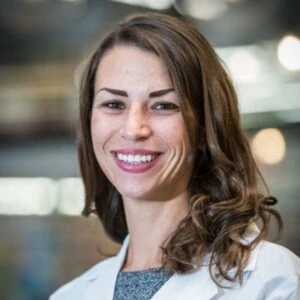
Renee Marinelli, MD
Dr. Marinelli has practiced family medicine, served on the University of California Admissions Committee, and has helped hundreds of students get into medical school. She spearheads a team of physician advisors who guide MedSchoolCoach students.
See How We Can Help
Search for:, recent posts, medschoolcoach, recent blog posts.

Q&A with Dr. Alice Zheng, MedSchoolCoach Advisor
Dr. Alice Zheng is a entrepreneur, physician, public health activist and MBA! She received her MBA from Harvard University and MD[...]
August 10, 2016
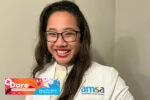
The Future Physicians for Change Conference: A Must-Attend Event for Aspiring Doctors
Explore Dr. Annelise Silva's medical journey to becoming AMSA President, preview the Future Physicians for Change Conference, and learn about[...]
May 15, 2024

How to Make Your Med School Application Stand Out
When medical school admissions committees review your application, they want to know you’re an applicant with a high likelihood of[...]
January 31, 2024
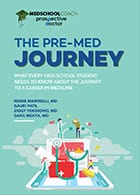
The Pre-Med Journey: What it Takes to Get into Medical School
Thinking about applying to medical school? Discover what high school students need to know about obtaining a career in medicine.
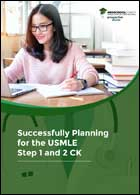
Successfully Planning for the USMLE Step 1 and 2 CK
Get ready for the USMLE Step 1 and Step 2 with this free guide to study planning and resource utilization.
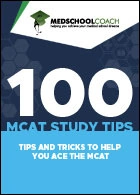
100 MCAT Study Tips
Taking the MCAT? These 100 tips and tricks will help you ace the MCAT.
Call us at (888) 381-9509
Call Us Now
Or, Schedule a Meeting Below

Happy April Fool’s Day from MedSchoolCoach!
While mastering sleep-learning is still a dream, mcat go helps you study for the mcat while you are awake. listen to mcat go for free (a $99 value) by entering your email below to receive an exclusive discount code. this ain’t no joke..

IMAGES
VIDEO
COMMENTS
The AACOMAS personal statement is an opportunity to tell your story and how your journey has led you to osteopathic medicine specifically. Why do you want to study osteopathic medicine? How do your values align with those of osteopathy?
The AACOMAS personal statement is required as part of your DO school application. Your personal statement gives admissions committees information about why you chose osteopathic medicine and why you want to be a doctor. Before you sit down to write your own statement, learn how to craft a perfect AACOMAS personal statement in our blog and take ...
Admissions committees want to know that you have the passion, ability, and will needed to succeed in osteopathic medical school. Learn more about what makes AACOMAS personal statements different in our AACOMAS Personal Statement Guide. Becoming an osteopath is hard.
The AACOMAS personal statement is for osteopathic medical schools specifically. As with the AMCAS statement, you need to lay out your journey to medicine as chronologically as possible in 5,300 characters with spaces or less.
In the Personal Information section, you will fill out your biographical and contact information, as well as citizenship status, race/ethnicity, and parental details (including education level). There is also a subsection for influences in which you will note any family members who are physicians.
personal statements. When you submit a personal statement for medical school or residency, you’re going up against applicants who are smart, driven and deeply passionate about medicine—just like you.
Read these examples of personal statements for prospective med students. Writing a great medical school personal statement is a lot easier with the right support. We’ve helped numerous med school applicants craft top-notch personal statements and can do the same for you.
This section is where you can write a personal statement that will be shared with all your osteopathic medicine schools. Once you submit your application, you cannot edit this section.
220+ medical school personal statement examples, plus a step-by-step guide to writing a unique essay and an analysis of a top-5 medical school personal statement.
Mention your clinical exposure and personal experiences and how they have directly influenced your decision to be a physician - most importantly, share your feelings. Use active language, complex sentences, simple sentences, and correct terminology.